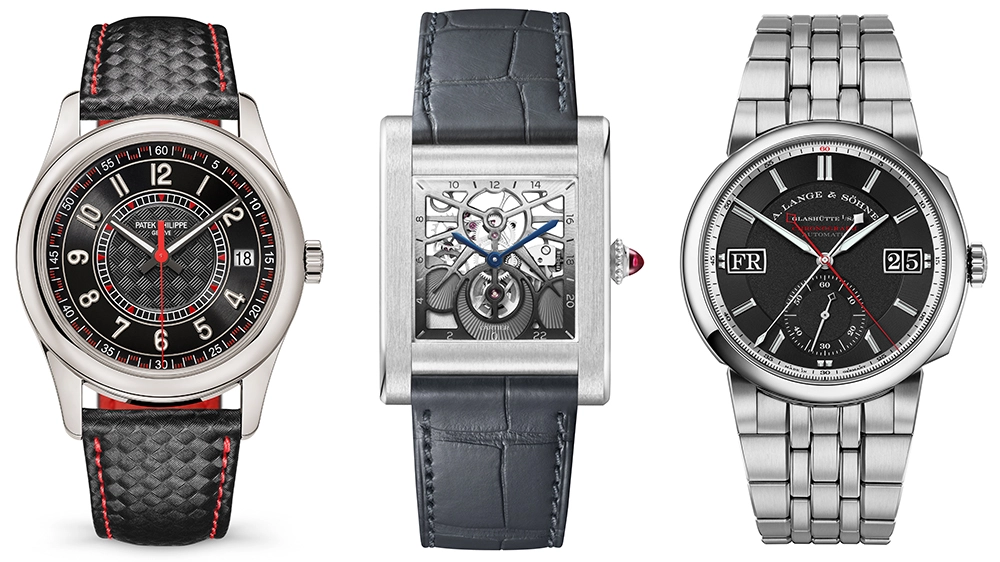
Watches & Wonders 2023
Let the games begin – from A. Lange & Sohne to Zenith, the first new releases have landed, with more to come. Here’s an initial look at the first drops.
Related articles
Watches & Wonders, the world’s biggest horological tradeshow, has arrived to deliver the year’s hottest new releases from the top luxury watchmakers.
So far, it’s shaping up to be a year in which many brands are revisiting established classics or recently minted heroes. Just before the show opened to journalists and retailers on Monday, several brands released a multitude of first looks, many of them familiar takes on memorable designs. A. Lange & Söhne revisited its one and only sports model, the Odysseus, and updated it with its first in-house automatic movement. Cartier rendered its Tank Normale anew, including a few complex skeletonised versions. Now that it’s achieved a laundry list of world records for the Octo Finissimo, Bulgari decided to focus on its Octo Roma collection and revealed two particularly elevated tourbillon models. And Van Cleef & Arpels delivered another round of the extraordinary table clocks that wowed the crowds at last year’s fair, which will please any very well-heeled clients that couldn’t get their hands on the $1 million-plus museum-worthy pieces.
There will, of course, be more to come. While Patek Philippe released images of a revamped Calatrava, its other releases (as well as Rolex’s breathlessly awaited new watches) will be shared later on Monday morning. For now, here’s a taste of what’s in store for watch enthusiasts this year.
A. LANGE & SÖHNE
A. Lange & Söhne Odysseus Chronograph

The esteemed German watchmaker is doubling down on its 4-year-old Odysseus collection of steel sport models with the debut of a timepiece featuring the manufacture’s first automatic chronograph movement. Limited to 100 pieces, the new chronograph places a premium on precision and legibility. Powered by the new L156.1 calibre, which incorporates an ingenious mechanism for resetting the chronograph hand to zero, the piece is marked by a combination of brushed surfaces and chamfered edges that emphasise its openness, as well as a dial architecture designed to create the illusion of depth.
Case Size: 42.5 mm
Case Material: Stainless steel
Power Reserve: 50 hours
Straps: Stainless steel bracelet
BULGARI
Bulgari Octo Roma Blue/Anthracite/White

Bulgari’s Octo Roma collection reimagines many typical watchmaking tropes through the lens of Italian flair, incorporating octagonal shapes reminiscent of ancient Roman buildings and offering a case shape that feels distinctly fresh and compelling. Expanding the basic, time-and-date Roma model this year, Bulgari is adding blue, anthracite, and white-dialed models to the lineup, each of which includes the beautiful clous de Paris motif. (This pattern, which appears as a series of small pyramids, can be found on numerous high-end timepieces from various brands.)
Each model comes in a 41 mm Octo Roma case and is powered by the automatic Calibre BVL 191 movement with a power reserve of 42 hours. Equipped with hands and indices that pop against the textured dial via a liberal coating of Super-LumiNova, each ships with both a matching rubber strap and the collection’s signature stainless steel bracelet. With its sophisticated case architecture and new, eye-catching dial design, the Octo Roma has become a competitive entry in the luxury sports watch genre that any die-hard—and even jaded—watch guy or gal would be proud to own.
Case Size: 41 mm
Movement: Bulgari Calibre BVL 191 automatic
Power Reserve: 42 hours
Bulgari Octo Roma Chronograph

Debuting this year within the Octo Roma collection is a new chronograph whose design cues may be familiar to some from the complication’s presence within the Octo Finissimo family. Powered by the automatic, in-house Calibre BVL 399 movement—which is visible via a sapphire caseback—it features a triple-register chronograph display with a 30-minute counter, a 12-hour counter, and a running seconds counter, plus a date window at 4:30. Subtly integrated chronograph pushers, a crown flanked by dual crown guards, and case architecture boasting a mix of polished and brushed surfaces make for a visually compelling look.
The visual star of the show is the same clous de Paris motif from the time-and-date models, available in white, anthracite, or blue and featuring a liberal coating of Super-LumiNova for nighttime legibility. Measuring 12.4mm thick and water resistant to 100m, the Octo Roma Chronograph ships on a beautiful stainless steel bracelet and also comes with a rubber strap that matches the watch’s dial colour. With its striking aesthetics, beautifully designed case, in-house movement, and multiple straps, it’s a tempting alternative to something like the Speedmaster, Daytona, or an El Primero.
Case Size: 42 mm
Movement: Bulgari Calibre BVL 399 Automatic
Power Reserve: 42 hours
Bulgari Octo Roma Precious Tourbillon Lumière

A ladies’ offering, the Octo Roma Precious Tourbillon Lumière competes squarely with any Octo men’s watch for sheer horological firepower but pairs it with a positively breathtaking case with more diamonds than a De Beers showroom. Measuring 38mm in rose gold, it’s set with no less than 267 round, brilliant-cut diamonds, plus a bezel set with 48 more—plus a rose gold crown set with a cabochon-cut ruby. (And if that isn’t enough diamonds and precious metal for you, you should consider moving into Buckingham Palace, because you may very well be the Queen of England.)
And on to the timekeeping: Powered by the manually wound, skeletonised Calibre BVL 208, it features small, central hands poised above a tourbillon housed at 6 o’clock. The rose gold movement is entirely hand decorated and boasts 64 hours of power reserve—more than enough to power it through the weekend. The dial itself is set with diamonds and nine brilliant-cut rubies to indicate the hours—in case you needed more bling. (Total carat count: ~5.05 for the diamonds, and ~0.18 for the rubies.) Paired with a red alligator strap with a diamond-set folding buckle, this is surely a timepiece for the woman who has everything else.
Case Size: 38 mm
Movement: Panerai Calibre BVL 208 Hand-Wound
Power Reserve: 64 hours
Octo Roma Precious Naturalia

Joining the Octo lineup is a precious metal doozy of a timepiece machined from gold and equipped with a flying tourbillon for good measure. Dubbed the Octo Roma Precious Naturalia, it celebrates the natural beauty of tiger’s eye, which is used in the construction of the dial indices. (More on that in a moment.) Housed in a 44mm, satin-brushed rose gold case measuring 11.35mm tall and water resistant to 50m, its stunning, skeletonised dial features a tiger’s eye plate with ample brown and gold accents, plus thin shavings of the same material that cover each of the 13 dial indices. Because of the unique properties of the stone, each dial is a one-of-a-kind piece of art.
Completing the gold aesthetic of the dial is a set of skeletonised hands and a flying tourbillon situated above 6 o’clock, plus a fully visible gear train. Powered by the manually wound, in-house BVL 206 movement with 64 hours of power reserve and paired with a brown alligator strap with a rose gold folding buckle, this is most certainly not a watch for someone who wants to fly under the radar—rather, it’s a prominent statement piece meant to exhibit every last ounce of Bulgari’s watchmaking savoir faire.
Case Size: 44 mm
Movement: Panerai BVL 206 Hand-Wound
Power Reserve: 64 hours
Bulgari Octo Roma Papillon Tourbillon and Striking Tourbillon Sapphire

For those for whom the standard Octo Roma offerings are insufficiently avant-garde, may we introduce the Octo Roma Striking Tourbillon Sapphire, which includes a unique complication: Housed in a 44mm titanium case with black DLC coating, it features a crown with a special push-button device at 3 o’clock. Engage this button, and a small red dot in the winding stem indicates that the crown can now be adjusted. Re-engage the button and the time setting is now deactivated, and the crown can be used for manual winding of the tourbillon-equipped movement.
With its completely transparent sapphire dial, mid-case, and back, the watch’s skeletonised movement—the Calibre BVL 206 with 64 hours of power reserve—is on full display. Bright green Super-LumiNova-filled indices and a white-tipped handset discreetly handle time-telling duties, while the flying tourbillon is situated above 6 o’clock. With its rubberised, black alligator strap with green stitching and titanium folding buckle, this futuristic offering is one of the standout models in the current Octo Roma collection, and proof that the Octo Finissimo line isn’t the only place where Bulgari’s most innovative watchmaking can be found.
Case Size: 44mm
Movement: Bulgari Calibre BVL 206 Hand-Wound
Power Reserve: 64 hours
Bulgari Octo Roma Striking Papillon Tourbillon

Sticking with the black DLC titanium theme, we have a striking-looking—(actually, “striking” is even in the name)—piece, also with a flying tourbillon, but with the addition of a special minute display and a jumping hour display. Dubbed the Octo Roma Striking Papillon Tourbillon and housed in a semi-tactical, very futuristic looking 44 mm Octo case measuring 11.9 mm thick and featuring a sapphire mid-case, its dial looks like something out of a cool science fiction novel.
A mix of blacks and greens and transparent surfaces, the dial features a central tourbillon with a jumping hour display poised above it, plus a semi-circular minute display below. Along this display traverses a “butterfly” minute counter with dual, diamond-shaped hands—once the first counter reaches the end of the 60-minute display, the hands rotate 180 degrees, and the secondary hand retraces the path back along the arc. Powered by the hand-wound Calibre BVL 348 movement with 60 hours of power reserve and lit with plenty of Super-LumiNova, it’s paired with a rubberised black alligator strap with green stitching and a titanium folding buckle.
Case Size: 44 mm
Movement: Bulgari Calibre BVL 348 Hand-Wound
Power Reserve: 60 hours
CARTIER
Cartier Privé

For the past seven years, Cartier has selected a historic model from its archives (say, the Crash, the Tank Cintrée, or the Cloche), given it a fresh new design spin, and marketed it as a numbered and limited edition under its sought-after Cartier Privé label, a “collector’s collection,” as the brand calls it.

New to Privé this year, the Tank Normale offers seven takes on Cartier’s defining timepiece, the 1917 Tank. They include an hour/minute version—in yellow gold with a brown alligator strap or in platinum with a black alligator strap—that takes its proportions and beveled sapphire crystal from the original, as well as a complicated and skeletonised model that features a 24-hour complication marked by a sun and crescent moon, in either yellow gold or platinum (the latter available with or without diamonds). And in a groovy nod to 1970s style, the collection for the first time includes two models that come on yellow gold or platinum bracelets.
Case Size: 32.6 mm x 25.7 mm for the basic Tank Normale; 35.2 mm x 27.8 mm for the skeletonised version
Case Material: 18k yellow gold and platinum
Power Reserve: 36-38 hours
Straps: Alligator straps in grey, brown, blue, and black, and 18k yellow gold and platinum bracelets
Clash [Un]Limited
![Cartier Clash [Un]Limited](https://robbreport.com/wp-content/uploads/2023/03/CAR_CRWJMB0004_CCS_01_01_TC_2404939.png?w=300)
Between its stylish mix of round and square shapes, and intriguing juxtaposition of faceted corners and beveled dials, the new Clash [Un]Limited watch evokes the legacy of Jeanne Toussaint, the legendary designer who, as director of Cartier’s high jewelry department from 1933 to 1970, “dared to provoke glittering collisions between preciousness and the industrial aesthetic of ball bearings,” according to a press release.
All five quartz-powered variations of the Clash [Un]Limited revel in contrasts (say, between brushed and satin finishes), but none as unexpectedly as the coloured stone version, which comes in an enchanting gem-set case distinguished by surprising pairings of brilliant white diamonds, bright red coral, and mint green chrysoprase.
Case Size: 18.4 x 32.7 mm for the small models
Case Material: 18k yellow, rose, white and purple gold
Straps: 18k yellow, rose, white, and purple gold bracelets
Santos-Dumont

Cartier’s sextet of new Santos-Dumont styles includes a trio of manual-wind XL models in platinum, rose gold, and yellow gold. The standout features are dials decorated with Roman numerals cut directly in jasper, jade, and dumortierite, to match the colours of the cabochons on the winding crowns.
For anyone who enjoys gazing at a complex movement, the Santos-Dumont Skeleton watch—available in a case made of yellow gold, rose gold, or steel—is just the ticket.
Case Size: 46.6 mm x 33.9 mm for colourful versions, 31 mm for skeleton edition
Case Material: 18k rose gold, 18k yellow gold and platinum
Straps: Alligator straps in green, blue, grey, burgundy, and brown
Santos de Cartier

The storied Santos line now includes three models featuring deeply saturated dials in green and navy blue, coated in a thin layer of tinted lacquer and applied by hand.
Case Size: 35.1 mm for the two medium models, and 39.8 mm for the large
Case Material: Steel
Straps: Interchangeable straps in steel and alligator
Tank

For more than a century, the Tank watch by Cartier, not to mention the family of timepieces it spawned, has adorned the wrists of the global elite. No wonder the Maison is perpetually recreating it. This year sees updates to three classic Tank models: the Tank Américaine, the Tank Française, and the Tank Louis Cartier.
The Tank Américaine was born in 1989 when the maison introduced a slender version of the model in a gently curved case reminiscent of the Tank Cintrée. For 2023, the house revisited the Tank Américaine in 11 new styles (nine featuring quartz movements) designed to be even slimmer. Available in all-gold and steel with a leather strap, rose gold and diamonds with a leather strap or diamond-paved white and rose gold with a metal bracelet, the Tank Américaine is proof that thin is perennially in.

The Tank Française made its debut in 1996 in a chic metal bracelet style. Now, the quartz-powered steel watch features a revamped bracelet with a gentle curve to fit all wrists. Note the diamond-set brancards, which play off the model’s polished finishes and sunray-brushed dial.

In 1921, Cartier widened the Tank’s case, refined its brancards and softened its edges to create the Tank Louis Cartier. New for this year is an LC model in yellow or rose gold on an alligator strap with a graphic motif on the dial rendered in three shades of gold—an homage to the Tank Must dials of the 1970s. The Tank Louis Cartier also comes in two minimalist coloured dial editions: one in lacquered burgundy and the other in a Platonic green, both encased in yellow gold. All three models feature the manual winding 1917 MC movement.
Case Size: 28 mm x 15.2 mm for the Tank Américaine mini, 35.4 mm x 19.4 mm for the Tank Américaine small, 44.4 mm x 24.4 mm for the Tank Américaine large, 25.7 mm x 21.2 mm for the Tank Française small, 32 mm x 27 mm for the Tank Française medium and 33.7 mm x 25.5 mm for the Tank Louis Cartier
Case Material: Steel, 18k yellow gold, 18k rose gold, 18k white gold
Straps: Alligator straps in dark blue, dark brown, red, grey, taupe and green
CHANEL
J12 Eclipse Box Set

Taken together, this set of seven watches, each a piece unique, is the horological equivalent of a solar eclipse. From the first watch, in all white ceramic, to the seventh watch, in all black, the timepieces—which come equipped with automatic calibers certified by the Swiss Official Chronometer Testing Institute—are gradually eclipsed by a black band that grows wider with each successive model.
Case Size: 38 mm
Case Material: Matte black and white ceramic
Power Reserve: 70 hours
Straps: Matte black and white ceramic bracelet
Monsieur de Chanel Tourbillon

The fragment of meteorite that forms the dial of this striking black ceramic timepiece isn’t its only distinctive element. Set atop the cage of the flying tourbillon—marking the first time the Monsieur watch has featured the complication—is a lion head décor plate depicting the maison’s emblem. With the passing of each second, it spins in all its leonine majesty.
Case Size: 42 mm
Case Material: Matte black ceramic and steel
Power Reserve: 72 hours
Straps: Black nylon strap with black calfskin trim and lining
CHOPARD
Chopard L.U.C 1963 Heritage Chronograph

Hand-wound chronographs are prized among collectors, and Chopard’s contribution to this elite genre, a 25-piece limited-edition flyback chronograph with Geneva Seal certification, is likely to disappear fast. The L.U.C 1963 Heritage Chronograph has a minimalist, no-date dial, and a case made of Lucent steel, Chopard’s proprietary steel alloy made of 80% recycled elements. Vintage details include the car-dashboard-style hour markers from 05-60 for chronograph minutes and seconds, along with mushroom-shaped pushers and eco-green dial with matching stitching on the strap. Modern technology allows for a sapphire caseback through which to admire the decorated movement, the star of the show (sapphire crystals weren’t around in the ’60s). The Chopard hand-wound flyback chronograph caliber L.U.C 03.07-L is chronometer certified, with a 60-hour power reserve. Finishes include rhodium-plated bridges, yokes, levers and column wheel, circular graining for the base, straight-graining for the chronograph components and a Côtes de Genève motif on the bridges.
Case Size: 42 mm by 14.55 mm
Case Material: Lucent steel
Power Reserve: 60 hours
Straps: Brown calfskin, green lining, green bridle stitching with pin buckle
Mille Miglia Classic Chronograph

Chopard loves its traditions, and the annual Mille Miglia collector’s edition is one of is most enduring. Chopard has been timing the scenic race from Brescia to Rome since 1988 and co-President Karl-Friedrich Scheufele has personally taken part in the race every year since, covering more than 30,000 competition miles. This year’s edition, the 36th in the annual series, is slightly smaller than others, at 40.5mm, which makes it a little more wearable (and perfect for a ladies’ wrist!).

The case, bezel and crowns are made of Lucent steel, a Chopard alloy that it says is 50% harder than conventional steel. There are four dial colour options, matched to the paintwork and interiors of classic cars: Verde Chiaro (light green) and Rosso Amarena (cherry red), Nero Corsa (racing black) and, on a two-tone steel and gold model, Grigio-Blue (grey blue). A tachymeter scale is essential for calculating speed and distances, and plenty of Grade XI Super-LumiNova helps to navigate after dark. A slim bezel maximises the depth of the dial.
Case Size: 40.5 mm by 12.88 mm
Case Material: Lucent steel or Lucent steel and 18k rose gold
Power Reserve: 54 hours
Straps: Black rubber with 1960s Dunlop racing tire motif or calfskin leather.
Chopard Imperiale

The lotus flower is the signature motif of Chopard’s Imperiale collection. The model was launched in 1994, and the lotus motif has appeared in various ways on its dials, cases, crowns and movements ever since. In 2017, Chopard won the Grand Prix d’Horlogerie de Genève in the jewelry category with the Lotus Blanc, with diamond-set petals opening and closing at will on the dial. The new Imperiale depicts the lotus flower with overlapping petals within a polished rose gold lacework. Some of the gold petals are engraved and satin-brushed. These openworked petals are positioned against a disk that rotates once every 24 hours to represent night and day. After midnight, the star-studded sapphire dome representing night gives way to morning light represented by a white diamond sky. It was created using several artisanal techniques, starting with a mother-of-pearl disk that is lacquered in a cerulean gradient that, at night time, is decorated with seven gold-powder stars. Sapphires in six gradient shades of blue express the transition from day to night. Snow-set diamonds represent the daytime sky. The steady motion of the disk is driven by the L.U.C 96.30-L, with a 65-hour power reserve. Case, horns, bezel and inner dial ring are set with diamonds.
Case Size: 36 mm by 10.15 mm
Case Material: 18k rose gold
Power Reserve: 65 hours
Straps: Seamless blue pearlescent alligator with 18k gold pink buckle
Alpine Eagle 41 XPS

Chopard has been beefing up its Alpine Eagle collection recently, instilling the sporty model with complications and high watchmaking finishes. The new 41 XPS is a chronometer-certified, with a small seconds indicator, and is finished to the standards of the Poinçon de Genève. The ultra-thin (8mm) case is made of Lucent steel A223, which Chopard ays is ultra-resistant and takes a high polish, and it’s made of 85% recycled materials. Double barrels driving the flagship caliber L.U.C 96.40-L ensure a 65-hour power reserve. The “monte rose pink” dial is named for the second-highest mountain range in the Swiss Alps, and their characteristic pinkish shimmer. It resembles the salmon tint that is so popular in high-end sports watches at the moment. The finish is inspired by the eagle’s iris. It can be admired on a larger plane than previous models, since the bezel of this one is trimmed back.
Case Size: 41 mm by 8 mm
Case Material: Lucent steel A223
Power Reserve: 65 hours
Straps: Lucent steel A223 bracelet
GRAND SEIKO
Grand Seiko Masterpiece Collection Spring Drive 8-Day SBGD213

Every ounce of Grand Seiko’s watchmaking prowess is on display in the new SBGD213: a Spring Drive-powered masterpiece, it’s hand-set with 5.62 carats’ worth of diamonds, and 1.25 carats of blue sapphires. Housed in a truly magnificent, highly angular, Zaratsu-polished platinum case recalling the lion—Grand Seiko’s spirit animal, so to speak—it features 112 diamonds along its upper surfaces and a further 60 baguette-cut stones along the bezel. Even the crown is inset with a brilliant-cut sapphire that matches perfectly the deep blue colour of the dial.
Speaking of the dial: blue sapphires and baguette diamonds—each of which has been set by hand between pairs of 18K white gold rails—form the hour and minute indices. Executed by the Shinshu Watch Studio in the Shiojiri facility in Nagano prefecture, they make for a stunning display, and are further joined by an additional 48 diamonds and 12 blue sapphires around their periphery. Flipping the watch over reveals the Spring Drive movement sat beneath a sapphire caseback: With its one-piece bridge and Mt. Fuji-inspired design, the Caliber 9R01 is accurate to an impressive +/- 10 seconds per month and offers an 8-day power reserve due to three barrels arranged in sequence.
Case Size: 44.5 mm
Movement: Grand Seiko Caliber 9R01 Hand-Wound
Power Reserve: 8 days
Grand Seiko Masterpiece Collection Hand-engraved Manual-winding Spring Drive Limited Edition SBGZ009

A special limited-edition model within the Masterpiece Collection, the new SBGZ009 features a stunning, fully engraved case executed by hand in the town of Shiojiri by elite Grand Seiko craftsmen. Inspired by a forest of white birch trees at the foot of the North Yatsugatake Mountains in the eastern part of Shinshu, it’s housed in a 38.5mm platinum case and paired to a silver dial.
Superb craftsmanship characterises this timepiece: each case is polished to a distortion-free sheen via the Zaratsu technique, after which it’s hand engraved with individual grooves by engravers at the Shinshu Watch Studio. A silver dial in the brand’s beautiful birch pattern is joined by 14K white gold, diamond-cut hour markers, plus a handset with curved minute and seconds hands and a minute track that’s carved into the dial periphery. Powered by the manually wound Spring Drive Caliber 9R02 with an 84-hour power reserve, it’s accurate to an incredible one second per day, and comes paired to a black crocodile strap with three-fold clasp and push button release.
Case Size: 38.5mm
Movement: Grand Seiko Spring Drive Caliber 9R02
Power Reserve: 84 hours
Grand Seiko Evolution 9 Collection Tentagraph SLGC001

A truly notable release, the Evolution 9 Collection Tentagraph SLGC001 is Grand Seiko’s first mechanical chronograph. An entry within the Evolution 9 sports watch collection, it’s powered by the 9SC5, which chirps along at 10 beats per second and features dual barrels for a power reserve of three days, even when the chronograph is in operation—making it, according to GS’s research, the 10-beat chronograph with the longest power reserve on the market. Tested for 20 days to ensure that it meets the Grand Seiko Standard of +5 to -3 seconds per day, it’s also highly accurate and thoughtfully engineered.
Housed in a Zaratsu-polished 43.2mm titanium case with a box-shaped sapphire crystal featuring anti-reflective coating, paired to a matching bracelet with a three-fold clasp with push button release, and complemented with a screw-down crown and a sapphire case back, the Tentagraph has a handsome dial to match its impressive construction and movement: Executed in a blue “Mt. Iwate” pattern, it boasts a triple-register chronograph display, a date window at 4:30, beautifully polished, applied indices and hands, and a black ceramic bezel with a tachymeter scale. Not bad for a first effort at a mechanical chronograph!
Case Size: 43.2 mm
Movement: Grand Seiko 9SC5
Power Reserve: 72 hours
HUBLOT
Big Bang Integrated Tourbillon Automatic Full Texalium-Carbon

Whether one loves or hates its case silhouettes, there’s simply no denying that Hublot is at the cutting edge of what it terms “the art of fusion”—integrating disparate materials that come together in a cohesive whole to tell a uniquely contemporary horological story. This year, this fusion has been put on full display in the form of the Big Bang Integrated Tourbillon Automatic Full Texalium-Carbon, a watch that surely knows few equals with regard to aesthetics, engineering, or creativity.
Measuring 43mm in ultra-lightweight carbon fiber, the watch is coated in Taxalium, a material that integrates fiberglass in a resin core with a thin layer of aluminum for increased impact resistance. Paired with a specially fabricated Texalium and carbon fiber strap that weighs just 26 grams and features individually machined and finished links, the Integrated Tourbillon Automatic is powered by the HUB6035 Manufacture Calibre movement, which features a micro-rotor and tourbillon as well as a 72-hour power reserve. With its mesmerizing looks, incredible engineering, and lightweight construction, it’s surely one of the standout references in the Big Bang lineup.
Case Size: 43 mm
Movement: Hublot HUB6035 Manufacture Calibre Automatic
Power Reserve: 72 hours
Big Bang MP-13 Tourbillon Bi-Axis Bi-Retrograde Titanium

2023 marks the entry of several firsts into the Hublot catalog, the latest of which is impossible to miss: the new 44mm Big Bang MP-13 Tourbillon Bi-Axis Bi-Retrograde Titanium is an absolute bruiser of a watch combining—for the first time in the brand’s history—a tourbillon and retrograde display in one timepiece. And not just any tourbillon, mind you: Hublot’s status as a completely integrated manufacture has allowed it to develop a bi-axis tourbillon entirely in-house, a considerable horological feat. (The tourbillon makes one rotation every minute on one axis, and one rotation every 30 seconds on its second axis).
Skeletonised and suspended without the use of an upper movement bridge, this impressive complication—and the HUB6200 manually wound movement housing it—is visible via anti-reflective sapphire crystal on both sides of the case. An impressive 96-hour power reserve ensures that the mesmerizing tourbillon can run for days without the need for winding. Limited to just 50 numbered pieces, it’s made of satin-finished and polished titanium and comes paired to a black rubber strap.
Case Size: 44 mm
Movement: Hublot HUB6200 Manufacture Calibre Manual Winding
Power Reserve: 96 hours
Big Bang Square Unico Sapphire

Building upon the success of 2022’s Square Big Bang Unico, Hublot is expanding the collection with a unique sapphire variant meant to showcase the brand’s tremendous savoir faire and expertise with cutting-edge materials. Part of a limited run of 250 pieces, this impressive, transparent timepiece has a water resistance of 50m despite the challenges of engineering not only a square case but one machined from multi-layered sapphire. Powered by an in-house movement dubbed the HUB1280, it features a 72-hour power reserve, automatic winding, and a column wheel flyback chronograph complication. All of this impressive clockwork can, of course, be admired via the watch’s openwork dial and sapphire case.
Fitted to a rubber strap with a titanium deployant clasp, the Big Bang Square Unico Sapphire is further joined by two sister references in black or white ceramic, which are powered by the same movement, but aren’t limited editions. Each watch features the “One Click” system, meaning its straps can easily be swapped out for other Hublot bracelets.
Case Size: 50 mm
Movement: Hublot HUB1280 Manufacture Calibre Automatic
Power Reserve: 72 hours
IWC
IWC Ingenieur Automatic 40

IWC is reviving the Ingenieur Reference 1832, along with the man who created it, Gerald Genta, the maestro of watch design. The Ingenieur (“engineer” in French) was IWC’s ultimate answer to the Asian-invasion of affordable quartz watches and the decline of traditional gold dress watches in the 1970s. An early version of the Ingenieur was introduced in the late ’50s, but the model really came into its own when IWC decided to enlist Genta in the 1970s to redesign it according to the spirit of the times. His brief was to create a robust yet elegant steel sports watch that would be accessible and unique. In 1976, Genta delivered the SL ref. 1832 Ingenieur in a 40mm steel case with an integrated steel bracelet, a checkerboard-pattern dial and a distinctive screw-on bezel with five recesses. Because 40mm seemed huge at the time, the watch was nicknamed the “Jumbo.” Genta had already designed Audemars Piguet’s now-iconic Royal Oak by then, and would go on to design Patek Philippe’s legendary Nautilus a year later. The new Ingenieur Automatic 40 is a tribute to the original 40mm Jumbo. Updates include a slightly curved case ring and a redesigned bracelet with closed links and no visible pins. On the original bezel, the screws were decorative, but on the new one, the five screws secure the bezel to the case ring, so they have a technical function as well. The dial has the same grid pattern as the original. Dial options include black, silver-plated or aqua. All contain the IWC-manufactured 32111 caliber with a power reserve of 72 hours.
Case Size: 40 mm
Case Material: Stainless steel
Power Reserve: 72 hours
Straps: stainless steel bracelet with butterfly folding clasp
MONTBLANC
1858 Unveiled Secret Minerva Monopusher Chronograph Limited Edition

In 1858, Charles-Ivan Robert opened a workshop on the site of an ancient mill in the Swiss village of Villeret. In homage to his fascination with Roman mythology, he named it Fabrique d’Horlogerie Minerva. The firm survived the ravages of the 1970s, clinging to its independence until 2006, when it was acquired by Financière Richemont and transferred to Montblanc.
In the intervening years, the German brand has used Minerva’s legacy as a springboard for contemporary creations in its 1858 collection—chief among them the new 1858 Unveiled Secret Minerva Monopusher Chronograph, available in a limited edition of 88 pieces. Equipped with a historic hand-wound Minerva MB M16.29 movement that’s been flipped over so its complexity is visible on the dial, the watch comes in a steel case with a black coating brushed with quartzite and limestones from the nearby mountains, lending the watch a uniquely distressed look that belies its elegance.
Case Size: 43 mm
Case Material: Distressed steel
Power Reserve: 50 hours
Straps: Black nubuck alligator leather strap
1858 Geosphere 0 Oxygen The 8000 Limited Edition

The Nepal-born mountaineer Nimsdai Purja is the inspiration for Montblanc’s new limited edition Geosphere automatic chronograph, a limited edition of 290 pieces that features a worldtime complication complete with two 3D globes—the Northern Hemisphere at 12 o’clock and the Southern Hemisphere at six o’clock. The former bears 14 orange dots, marking the location of the world’s 8,000+-meter peaks.
On the back of the watch’s 44 mm titanium case, a 3D coloured laser engraving depicts the list of the 14 peaks, the name of the watch, two inspirational quotes from Nimsdai and three Himalayan prayer flags for good fortune. Last but not least, the watch comes with an interchangeable anthracite textile strap that borrows its design from a rope, a tool that no mountaineer can do without.
Case Size: 44 mm
Case Material: Titanium
Power Reserve: 46 hours
Straps: Interchangeable anthracite textile strap
PANERAI
Panerai Radiomir Annual Calendar

Famed for its simple, time-only military watches, Panerai has been steadily expanding its offerings to include more complicated pieces executed in new, forward-thinking materials. New this year is a complication that has never before been part of the Panerai oeuvre—namely, an annual calendar. Housed within a 45mm Radiomir cushion case with “wire”-type lugs and onion crown, the PAM01363 features Goldtech construction, combining platinum and copper for a red appearance. Its sun-brushed blue gradient dial is an exercise in legibility, with a day-date display at 3 o’clock, a running seconds display at 9 o’clock, and an outer, rotating month disc with a fixed arrow at 3 o’clock as an indicator. Of course, the famous Radiomir “sandwich” dial is also present and accounted for.
Also available is a special Experience edition, the reference PAM01432. Purchasing this Platinumtech-cased beauty with its sun-brushed burgundy dial will get you a ticket to a Panerai-led experience in Rome, with “events that combine artisanal know-how, culture, and tours of historical sites.” Whichever reference you spring for, you’re getting an incredible, complicated timepiece powered by the P.9010/AC automatic movement, with 40 jewels, dual barrels, and 316 components.
Case Size: 45 mm
Movement: Panerai P.9010/AC Automatic
Power Reserve: 72 hours
Panerai Radiomir California PAM01349

While Panerai has long produced a version of its famed “California dial” Radiomir in the positively enormous size of 47mm, it has never ventured smaller. This year, the Italian-founded military outfitter has finally seen fit to shrink this model down to something that’s (slightly) more wearable for someone with a sub-8-inch wrist: Please join us in welcoming the 45mm Radiomir California PAM01349! With a deep green dial, this one is a playful twist on the typical “California” formula.
Taking inspiration from the historical reference 3646, it features the famous half-Roman, half-Arabic numerals of the “California” look, plus an outer railroad minute track and a lumed, blued steel sword handset. Cased in Brunito eSteel—a type of recycled metal with its origins in different industries—the watch features brand new hand finishing that gives it a cool, vintage look. It’s powered by the hand-wound Calibre P.5000 with an 8-day power reserve, and comes paired to a calf leather strap in dark brown with contrast stitching.
Case Size: 45 mm
Case Material: Brunito eSteel
Movement: Panerai Calibre P.5000 Hand-Wound
Power Reserve: 8 days
Panerai Radiomir Otto Giorno

Available in two compelling colours, the new Radiomir Otto Giorno recalls some of the earliest Panerai models made exclusively for military use in the 1930s. Housed in a 45mm e-Steel case whose PVD exterior is hand finished for a unique, vintage-inspired look, the watch features most of the characteristics that fans have come to expect from the typical Panerai diver: a highly legible “sandwich” dial with ample lume; a cushion case with “wire” lugs and an onion crown; and a hand-wound movement with an ample power reserve—in this case, the Calibre P.5000 that can run for eight days when fully wound, which lends the piece its name in Italian.
Both the dark brown (PAM0347) and blue (PAM01348) gradient dials transition from a darker edge to a lighter center, echoing the grainy, colour-changed appearance of certain early aluminum Panerai dials. Paired to Cuoio Toscano calf leather straps that match their respective dials and are meant to take on a distinct patina with time, each is a fitting tribute to the legacy of this most distinctive of specialist, legacy watchmakers.
Case Size: 45 mm
Movement: Panerai Calibre P.5000 Hand-Wound
Power Reserve: 8 days
Panerai Radiomir Quaranta in Goldtech

Did we mention that Panerai’s focus this year is on the Radiomir collection? (Well: Panerai’s focus this year is on the Radiomir collection.) So without further ado, here’s one more Radiomir release to tickle your vintage-inspired fancy: the Quaranta in Goldtech. Godltect is Panerai’s own proprietary blend of gold, platinum, and copper that shines in a bold red colour—and nowhere does it look better than constituting the case of this most contemporary of Radiomirs.
Shrunk down from its 47mm origins, the Quaranta is so named for its 40mm size. At just 10.15mm thick—the slimmest in the brand’s entire oeuvre—it makes for a highly wearable, everyday watch…provided you can pull off a hulking hunk of gold on an everyday basis. Paired to an elegant alligator strap and fitted with a radially brushed, white “sandwich” dial, it’s powered by the impressive Calibre P.9000, an automatic movement measuring just 4.2mm tall and boasting a three-day power reserve. Positioned as a genderless, versatile piece for any type person on any occasion, it’s certainly a stunner and a fabulous example of Panerai’s adaptation of military-born tech into a contemporary guise.
Case Size: 40mm
Movement: Panerai Calibre P.9000 Automatic
Power Reserve: 72 hours
PATEK PHILIPPE
Patek Philippe Calatrava 6007G-001, 6007G-010 & 6007G-011

Patek Philippe just released three new Calatrava references, each with a white gold case, ebony dials and its own accent colour: red, yellow, or pale blue, rendered on the seconds track, seconds hand, indexes, and the stitching of the matching leather strap. The intriguing dials feature a crosshatch pattern reminiscent of carbon fiber, which matches the treatment on the strap, giving each of the trio a distinctly sporty feel.
Case Material: White gold
Straps: Leather with yellow, red, or blue stitching
Movement: Self-winding calibre 26-330 S C
ROGER DUBUIS
Roger Dubuis Monovortex Split Seconds Chronograph

Roger Dubuis watches seem to exist in two parallel universes. On the one hand, every single watch is finished in excruciating detail according to the traditional finishing conventions outlined by the Geneva Seal. On the other hand, every watch has the aesthetic of a hyper-modern, colourful, openworked, technically futuristic superwatch. They always look as if they have somehow exploded into being, in a good way. Roger Dubuis is also known for its tourbillons, and the Monovortex Split Seconds Chronograph has one of those, positioned on 360-degree conical trajectory. It also has a turborotor: a cylindrical oscillating weight that rotates perpendicular to its axis. The caliber RD114 movement also drives a split-seconds chronograph controlled by a double-column wheel. And there’s an angular, isotoxal-shaped minute counter, a tripartite hand that Roger Dubuis calls the (120° Rotating Minute Counter, with arms that carry the tens digits (0,1 or 2) while pointing out the units digit. The case is made of a mineral composite fiber (MCF that is 99.95 percent silica, made via a sheet molding compound (SMC) process. Duguis says it is 13 percent lighter than SMC carbon. Certainly not your average traditional wristwatch.
Case Size: 47 mm
Case Material: Mineral composite fiber (MCF)
Straps: Bi-material fabric
TAG HEUER
Carrera Plasma Diamond d’Avant Garde

Remember that stunning, diamond-encrusted TAG Heuer Carrera Plasma Diamont d’Avant Garde from 2022? Well, there’s another one this year—and it’s even more diamond-y. The new Plasma sets artificial diamonds all throughout the bezel, bracelet, dial, crown, and more, making for a stealthily blingy watch—and we say “stealthy” because the entire case is black aluminum—that nevertheless delivers a serious horological punch in the form of the Calibre Heuer 02T Nanograph COSC movement with tourbillon.
A whopping 15.5 carats of lab-grown diamonds—124 of ‘em, for those who are counting—encrust every available centimeter of this timepiece. (Even the indices are diamonds!) Housed in a 44mm sandblasted aluminum case with a 2.5-carat diamond crown, its dial is composed of three polycrystalline diamond plates that form a sparkling surface against which a set of rhodium-plated hands indicate the time. The aforementioned Calibre Heuer 02T Nanograph boasts 65 hours of power reserve and extensive hand finishing, making this Plasma one heck of a statement piece, both outside and in.
Diameter: 44 mm
Movement: TAG Heuer Calibre Heuer 02T Nanograph COSC Automatic
Power Reserve: 65 hours
Aquaracer Professional 200

TAG Heuer’s Aquaracer line is most typically associated with the high seas, representing as it does the famous chronograph maker’s take on the contemporary dive watch. However, utility and flair are, as we know, most decidedly not mutually exclusive. To wit, the new Aquaracer Professional 200—two solid-gold takes on the brand’s popular aquatic timepiece. Available in 18K 5N rose gold or 18K 3N yellow gold, both are thoroughly modern divers powered by the brand’s new manufacture movement, the COSC-certified Calibre TH31-00, which boasts an 80-hour power reserve and comes complete with a five-year warranty.
The first such Aquaracer models with solid gold cases and bezels, each 40mm sports watch features a contrasting, DLC-coated crown and a DLC-coated Grade 2 titanium caseback with a sapphire window. Water resistant to 200m and featuring striking fumé gradient dials (blue on the yellow gold model and black on the rose gold), they come paired to blue or black rubber straps with DLC Grade 2 titanium folding clasps. A liberal application of SuperLumi-Nova ensures visibility below or above the waves, making the Auqaracer Professional 2000 an excellent everyday option for summertime adventures.
(Meanwhile, if solid gold is too much gold, you may be interested in two new bi-colour editions of the gold Aquaracer Professional 200, available with bezel inlay, crown, and dial detailing in 18K yellow or rose gold. Two models at 40mm are powered by the automatic TAG Heuer Calibre 5, while two ladies’ models at 30mm feature fumé mother of pearl dials with diamond-set indices, and are powered by the automatic Calibre 9 movement.)
Diameter: 40 mm
Movement: TAG Heuer Calibre 5 Automatic
Power Reserve: 38 hours
Carrera Chronograph

The story of the Carrera Chronograph continues apace with the introduction of several new models this year. Two of these are fresh colourways that bring (even more) automotive influence to a watch designed way back in 1963 and named after the famed Carrera Panamericana race that took place in Mexico: Available in black or blue, each watch boasts bright orange pops of colour that recall the speedometers on vintage race cars. Measuring 42mm in stainless steel, each also features a triple-register chronograph with recessed hour and minute totalisers, a running seconds totaliser above 6 o’clock, a lumed sword handset, and an outer 1/5th-second track positioned along the rehaut.
Uniquely, both models have date windows placed in different spots on the dial: the blue variant’s date is situated within the running second’s display above 6 o’clock, while on the black model, it can be found below 12 o’clock, recalling certain vintage Carrera “Dato” models. Paired to matching calfskin leather straps in blue or black, each is powered by the automatic Calibre Heuer02 movement, is water resistant to 100m, and features a display caseback.
Case Size: 42 mm
Movement: TAG Heuer Calibre HEUER02 Automatic
Power Reserve: 80 hours
Carrera Chronograph “Glassbox”

Perhaps the most exciting TAG Heuer release of the year for diehard Carrera fans, the new TAG Heuer Carrera “Glassbox” models are the direct descendants of the original 1963 racing chronograph—vintage reissues aside. Jack Heuer famously suffused his original Carrera watch with subtle midcentury influences found in the likes of Oscar Niemeyer’s architecture, or Ludwig Mies van der Rohe’s furniture, giving this small chronograph the subtleties and thoughtful touches that made it a horological classic. Likewise, the new 39m stainless steel “Glassbox” models—so called because their sapphire crystals resemble the profile of the acrylic crystals used on original 1960s watches—feature a bevy of thoughtful touches:
The curved sapphire crystal effortlessly flows over a tachymeter scale that runs along the dial edge, allowing the scale to be read from a wider variety of vantage points. This edge curves inward to reveal a 1/5th-seconds track along a flange that frames the applied dial indices, while a triple-register chronograph in recessed totalisers blends into a blue dial, or pops against a black main dial in a “panda” effect. A lumed sword handset and a date at 12 o’clock (black dial) or 6 o’clock (blue dial) finish the contemporary look. Powered by the automatic TH20-02 caliber—an updated version of the Heuer 02 chronograph movement with elevated finishing and bi-directional winding—round out this most excellent update to a true classic.
(There’s also a tourbillon-equipped version housed in a 42mm version of the Carrera case, powered by the automatic Calibre TH20-09 Automatic COSC movement and boasting a dual-register chronograph display. Paired to a blue calfskin strap, it’s a notable model within the greater catalog—and all the more special because of TAG Heuer’s positioning as more of an entry-level brand that doesn’t typically delve too far into such elite complications as the tourbillon.
Case Size: 42 mm
Movement: TAG Heuer Calibre TH20-09 Automatic COSC
Power Reserve: 65 hours
ULYSSE NARDIN
Ulysse Nardin Freak One

Ulysse Nardin Freak One
Ulysse Nardin is introducing the ultimate Freak in honor of the game-changing watch it launched in 2001. Designed by notable watchmaker and physicist Dr. Ludwig Oechslin, the Freak represented a fresh expression of watchmaking. It had no dial – just an open view of the movement. Nor did it have hands- time was indicated by a one-hour carrousel tourbillon that pointed to an index as it rotated. And instead of a crown, time was set by winding a device on the caseback that was connected to a system built into the bezel. The new Freak One recaptures the spirit of the original 2001 Freak and adopts the best innovations introduced in the eight variations that have appeared since. It is regulated by a silicon hairspring first introduced in 2008, along with an escapement treated with shock-resistant DIAMonSIL, was first applied to the Freak in 2007. It repeats the iconic notched bezel of the original 2001 Freak, the open gear train of the Freak Cruiser of 2013, and the legibility codes of the 2018 Freak Vision. The black DLC-coated titanium and rose gold detailing echoes other recent Freak iterations, such as last year’s Freak S.
Case Size: 44 mm by 12 mm
Case Material: Black DLC-coated titanium
Power Reserve: 72 hours
Straps: Black textured rubber, black alligator two-tone rubber
VACHERON CONSTANTIN
Traditionelle Tourbillon Retrograde

It’s a retrograde year for Vacheron Constantin. The display, which requires extreme precision, is a longtime tradition for the brand, a complication in itself that became popular in the 1920s. Vacheron is applying it to three new models this year. The first is the Traditionelle Tourbillon Retrograde, which combines a tourbillon with a retrograde date display. The movement, automatic caliber 2162 R31, is visible on the openworked dial and given a slate grey NAC surface treatment that contrasts with the traditional features of the watch. The date is tracked on a retrograde arc across the top half of the dial. Once the arrow hand reaches the 31, it jumps back to the beginning at the next date change, starting at 1 again. The watch retains the main design codes of the Traditionelle line, including stepped round case and lugs, a fluted caseback, a slim bezel, a railway minute-track, bi-faceted Dauphine hands and gold baton-style hour-markers. It is finished to Geneva Hallmark standards.
Case Size: 41 mm x 11.07 mm
Case Material: 18k pink gold
Power Reserve: 72 hours
Straps: Gray alligator
Patrimony Retrograde Day-Date

The combination of platinum case, salmon dial and double retrograde is enough to tell you that this is a watch will be a fast sell-out. This boutique-only edition won’t last. The dial is classically minimalist, with needle-thin central hour and minute hands and eccentric details like long pointed hash marks at 3, 6 and 9 o’clock, pearled 18k white gold minute markers and an 18k gold Maltese cross, the brand’s logo, at 12 o’clock. The date/day retrograde arcs at top and bottom are marked by skeletonised blued steel hands.
Case Size: 42.5 mm x 9.7 mm
Case Material: Platinum
Power Reserve: 40 hours
Straps: Blue alligator
Overseas Moonphase Retrograde

This is Vacheron’s first sports watch with a retrograde display, and a very rare example of a retrograde moon phase arc. The moon phases are displayed through a 6 o’clock aperture and also read on a graduated from 0 to 29½, indicating the number of days elapsed since the last new moon. It’s a precision moon phase, requiring a one-day correction only once every 122 years. The retrograde date arc above is subtle, with a blue hand over the background of a blue dial. The watch retains the signature features of the Overseas collection: six-sided bezel evoking the Maltese cross, fluted crown, polished and satin-brushed finishes, translucent lacquered dial, luminescent hour-markers and hands. it is Geneva Hallmark certified.
Case Size: 41 mm x 10.48 mm
Case Material: Stainless steel
Power Reserve: 40 hours
Straps: Stainless steel; calfskin leather; blue rubber
VAN CLEEF & ARPELS
Van Cleef & Arpels Planetarium Automaton

One of Van Cleef’s introductions for 2023 is a universe unto itself. Following on the groundwork laid by its Planetarium watches, introduced in 2014, and a massive automaton clock unveiled at Watches and Wonders last year, is a new edition of the Planetarium Automoton clock that offers a new combination of materials. This version is complemented with a black Aventurine glass dial, which helps to make the sparkling sun at the center and the seven planets that revolve around it look like they’re floating in outer space. It’s even accompanied by a special melody created in partnership with Swiss musician Michel Tirabosco.
Dimensions: 50 cm x 66.5 cm
Power Reserve: 15 days
Movement: Automaton and mechanical movements including a planétarium and 11 other modules such as hour/minute display, perpetual calendar
Van Cleef & Arpels Floraison du Nénuphar Automaton

This is the first of two unique automaton clocks Van Cleef & Arpels dedicated to nature and created with the help of the Francois Junod workshop. On command, they both open their floral crowns and reveal a butterfly hidden within the petals of the blooom atop the piece. This model, the Floraison du Nénuphar, hides its butterfly completely inside its lotus-like flowers. Once it opens, the butterfly appears to hover, and flaps its wings in a natural motion for a few seconds before returning to the interior of the flower, which closes around it to complete the spectacle. It tells time with a ring on the outside of the base of the clock, around which a winged figure revolves to mark the time.
Dimensions: 27 cm x 21.5 cm
Power Reserve: 8 days
Movement: Automaton and mechanical movements
Van Cleef & Arpels Éveil du Cyclamen Automata

This clock’s animation is similar, but the flowers that surround the butterfly reveal a little more than its fellow new debut. At the touch of the button, their stems fall away and allow the enamel-painted insect inside to float above the petals momentarily, where it also flaps its wings before disappearing inside the pink enamel petals once more.
Dimensions: 27 cm x 21.5 cm
Power Reserve: 8 days
Movement: Automaton and mechanical movements
Perlée

Van Cleef & Arpels relaunched its Perlée collection last year with a new motif: beaded gold. It resembles the art of granulation, in which gold balls soldered onto a gold surface, but on the Perlée collection the effect is cast, so the row of beads is already solidly attached to the surface of the gold and then finished and polished by hand. Five new models in this delicately feminine collection (four with a 23mm case and one with a 30mm case) have decorative dials of pavé-set diamonds, guillochérose gold or guilloché mother-of pearl. Each comes with an interchangeable alligator strap along with second option from the collection. There is also a jewelry bracelet, composed of articulated gold beads.
Case Size: 23 mm or 30 mm
Case Material: 18k white or rose gold
Movement: quartz
Straps: Alligator or 18k gold bracelet
Precious Dance

Van Cleef takes the gold beaded motif to yet another level with this series of six pendant watches. The locket-like pendants are like small pocket watches, with gem-set cases that swivel open to reveal the time. Three are set with the big three precious gems: either sapphire, ruby or emeralds, in either rose or yellow gold, with matching gold chains. The cases of three others are set with ornamental stones. Bezels are ringed with diamonds and the dials are mother-of-pearl.
Case Material: 18k gold
Movement: quartz
Straps: 18k gold chain
Ludo Secret and Hexagone Macaron Secret

The Ludo bracelet, with its tightly worked mesh-like links, is a signature Van Cleef & Arpels creation, first introduced in 1934, nearly a century ago. The flexible, brick-pattern meshwork culminates in a belt-buckle-like motif that is set with either diamonds or pink sapphires, which makes for an outstandingly creative dial surround. The Ludo Hexagone Macaron secret watch, inspired by an archival creation from 1941, has a cover entirely blanketed with mystery set emeralds. It is surrounded by arcs of large, prong-set diamonds set claw-style for intense light return. Emeralds are also set into the bracelet links for a final, elegantly assertive touch.
Case Material: 18k gold
Movement: quartz
Straps: 18k gold
Lady Féerie Rose

The magical, mysterious, enchanting fairy is a signature motif for Van Cleef & Arpels, and the Maison never seems to run out of ways to interpret the delicate sprite – often in the service of poetic complications. Here, she is interpreted in shades of pink in the form of translucent plique-à-jour and opaque enamel, along with pink sapphires. She points her magic wand to numerals on a retrograde arc to read the minutes, while the hours appear in a mother-of-pearl jump-hour window that appears to emerge from the white enamel clouds on which the fairy is poised. Her wings, head and body are formed with diamonds, which are also set into the bezel.
Case size: 33 mm
Case Material: 18-karat rose gold
Movement: Self-winding mechanical
Straps: Alligator
ZENITH
Zenith Pilot Automatic

While you may more readily associate the pilot’s watch with Swiss brands such as IWC and German marques like Laco, Zenith has a longstanding history in the vertical that runs more than skin deep: It was way back in 1888 that the maison first filed a trademark for the French term “Pilote”—and subsequently, the English term “Pilot”—to be used on watches designed for those who would brave the skies. This year’s Pilot Automatic, then, represents a brand new, thoroughly contemporary chapter in the firm’s pilot’s watch saga: Measuring 40mm in stainless steel or black ceramic, it’s an exercise in the marriage of vintage-inspired tropes with modern watchmaking.
Both versions of the Pilot automatic feature rounded cases topped by flat-top, rounded bezels; the steel version boasts vertically satin-brushed surfaces and polished chamfers, while the black version is microblasted. Both likewise feature a modern take on the oversized “onion” crown of vintage pilot’s watches, which remains easy to manipulate—even with gloves on—and is devoid of crown guards. With its black opaline dial executed in horizontal grooves to echo the look of a vintage, corrugated metal plane, the Pilot Automatic still features large Arabic indices, an outer, white minute track, and a highly legible sword handset—echoes of classic pilot’s watches of years past.
Powered by the automatic Zenith El Primero 3620 movement with high-beat, 5Hz frequency and 60-hour power reserve, the watch comes paired with two straps: a black Cordura-effect rubber strap and a khaki Cordura-effect strap. Both feature triple-folding clasps with black PVD coating.
Case Size: 40 mm
Movement: Zenith El Primero 3620 Automatic
Power Reserve: 60 hours
Zenith Pilot Big Date Flyback

Reserved and utilitarian as the Zenith Pilot Automatic is, Zenith must have felt there was room to riff on its revamped pilot’s watch collection and add a touch of je ne sais quois—which is precisely what the maison did when designing its Pilot Big Date Flyback. The name gives it all away: This awesome, modern take on the pilot’s watch trope includes an outsize date function, plus a chronograph with a flyback complication. Best of all: it doesn’t quite look like anything else on the market.
Measuring 42.5mm in black microblasted ceramic or stainless steel, it puts Zenith’s decades of chronograph-making expertise front and center by incorporating the El Primero 3600 movement, which has been modified specifically for these new references into the Caliber 3652. Automatically wound and beating at 5Hz, it powers an outsize date above 6 o’clock on the dial, as well as a flyback function, which allows the chronograph seconds hand to be reset to zero and re-engaged without a series of time-sucking button presses. And while the ceramic version is its own animal, the steel version pays tribute to the “Rainbow Flyback” chronograph from 1997, which was the brand’s first El Primera-based flyback model.
Case Size: 42.5 mm
Movement: Zenith El Primero 3652 Automatic
Power Reserve: 60 hours
Subscribe to the Newsletter
Recommended for you
Watches & Wonders 2024 Showcase: Hermès
We head to Geneva for the Watches & Wonders exhibition; a week-long horological blockbuster featuring the hottest new drops, and no shortage of hype.
By Josh Bozin
July 24, 2024
Watch This Space: Mike Nouveau
Meet the game-changing horological influencers blazing a trail across social media—and doing things their own way.
By Josh Bozin
July 22, 2024
You may also like.
By Josh Bozin
24/07/2024
You may also like.
5 Lounge Chairs That Add Chic Seating to Your Space
Daybeds, the most relaxed of seating solutions, offer a surprising amount of utility.
Chaise longue, daybed, recamier, duchesse brisée—elongated furniture designed for relaxing has a roster of fancy names. While the French royal court of Louis XIV brought such pieces to prominence in fashionable European homes, the general idea has been around far longer: The Egyptian pharaohs were big fans, while daybeds from China’s Ming dynasty spurred all those Hollywood Regency fretwork pieces that still populate Palm Beach living rooms. Even Mies van der Rohe, one of design’s modernist icons, got into the lounge game with his Barcelona couch, a study of line and form that holds up today.
But don’t get caught up in who invented them, or what to call them. Instead, consider their versatility: Backless models are ideal in front of large expanses of glass (imagine lazing on one with an ocean view) or at the foot of a bed, while more structured pieces can transform any corner into a cozy reading nook. Daybeds may be inextricably linked to relaxation, but from a design perspective, they put in serious work.
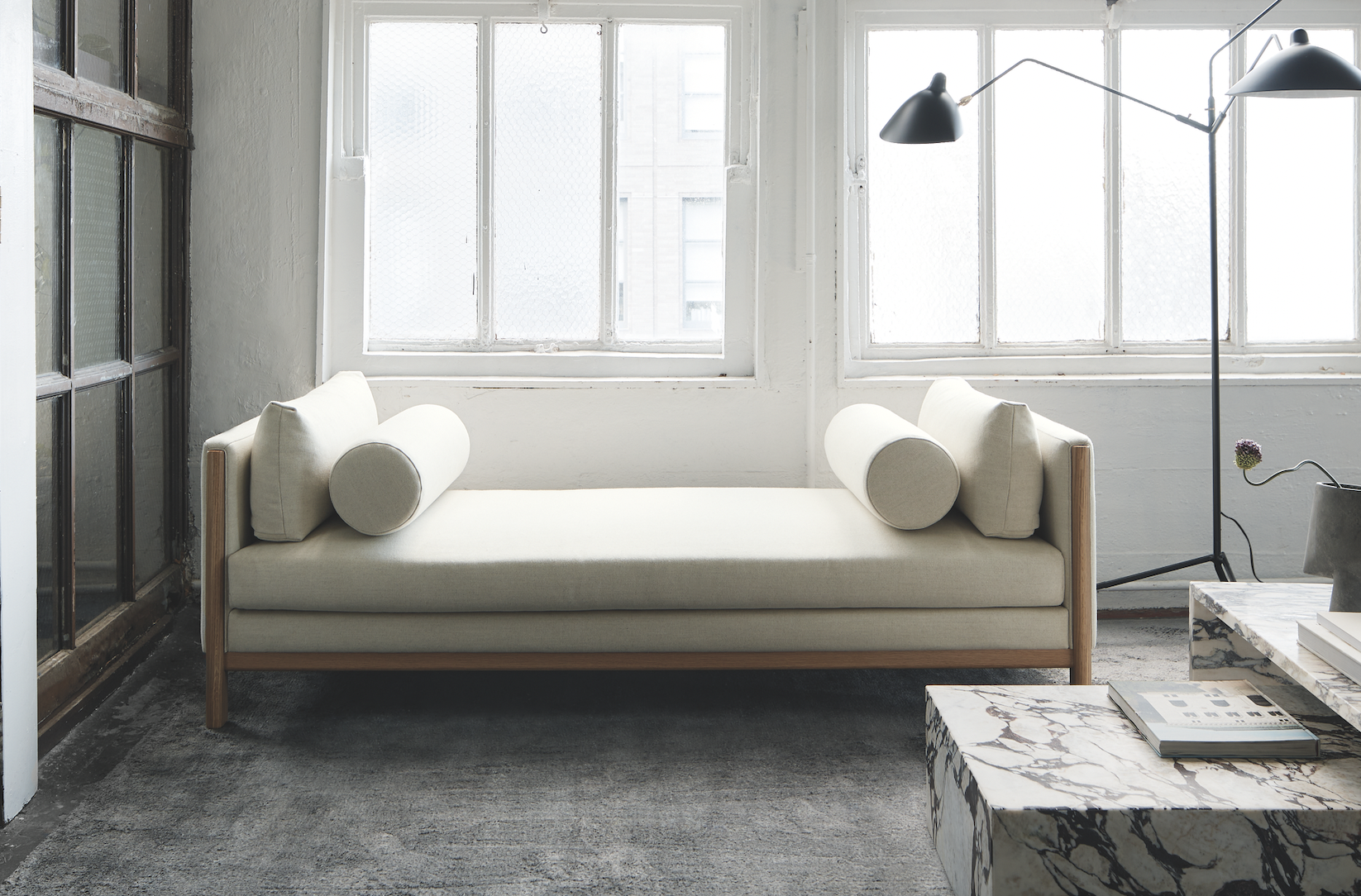
Emmy, Egg Collective
In designing the Emmy chaise, the Egg Collective trio of Stephanie Beamer, Crystal Ellis and Hillary Petrie, who met as students at Washington University in St. Louis, aimed for versatility. Indeed, the tailored chaise looks equally at home in a glass skyscraper as it does in a turn-of-the-century town house. Combining the elegance of a smooth, solid oak or walnut frame with the comfort of bolsters and cushioned upholstery or leather, it works just as well against a wall or at the heart of a room. From around $7,015; Eggcollective.com
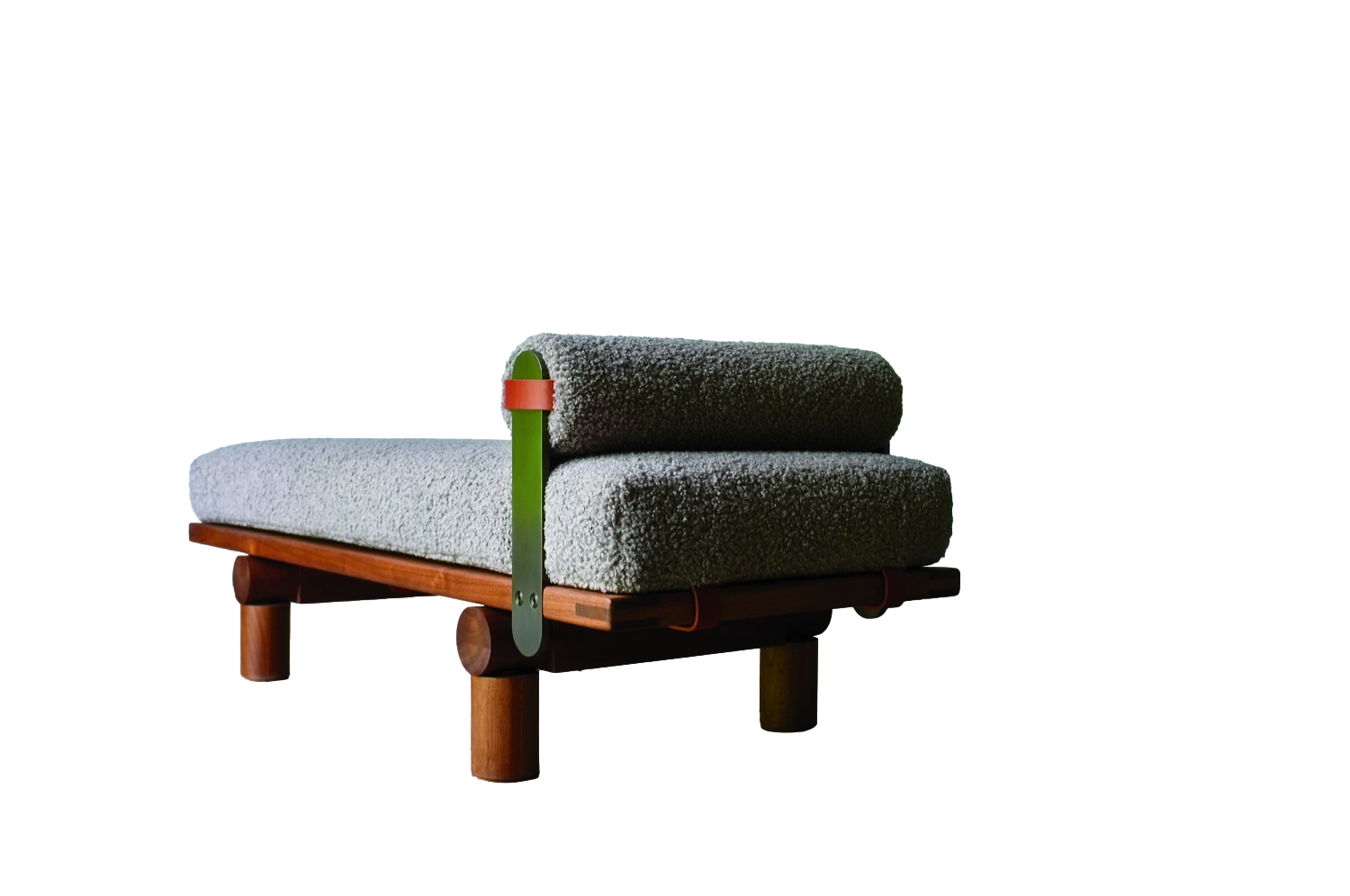 Plum, Michael Robbins
Plum, Michael Robbins
Woodworker Michael Robbins is the quintessential artisan from New York State’s Hudson Valley in that both his materials and methods pay homage to the area. In fact, he describes his style as “honest, playful, elegant and reflective of the aesthetic of the Hudson Valley surroundings”. Robbins crafts his furniture by hand but allows the wood he uses to help guide the look of a piece. (The studio offers eight standard finishes.) The Plum daybed, brought to life at Robbins’s workshop, exhibits his signature modern rusticity injected with a hint of whimsy thanks to the simplicity of its geometric forms. Around $4,275; MichaelRobbins.com
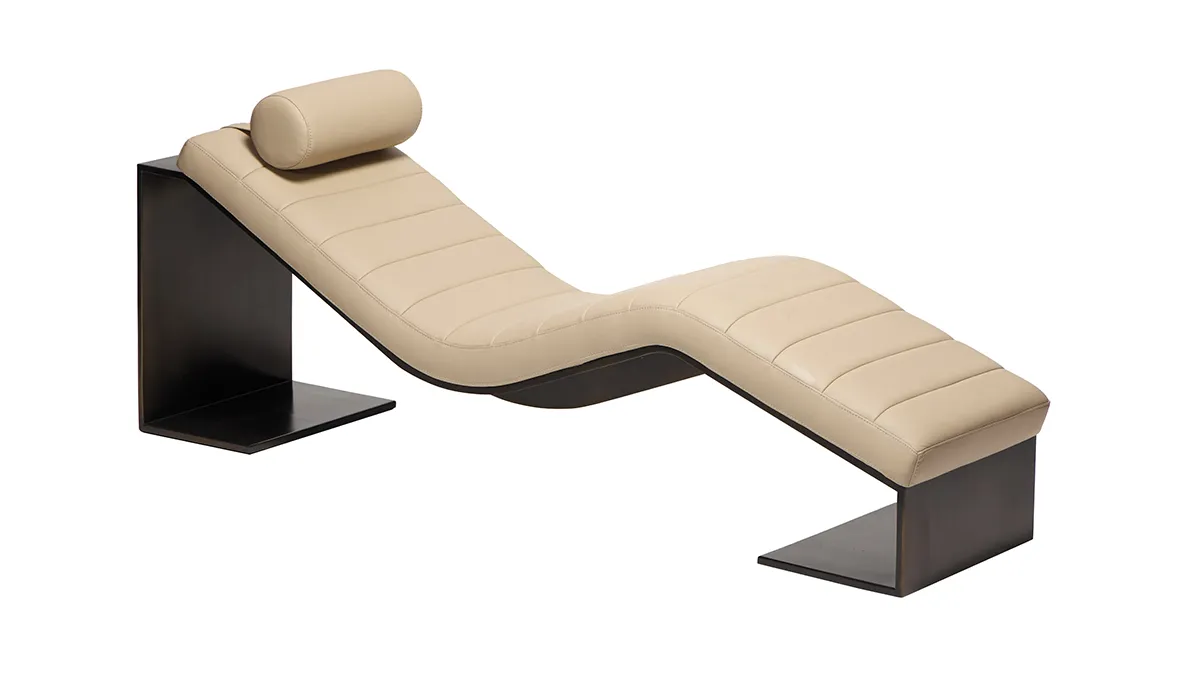
Kimani, Reda Amalou Design
French architect and designer Reda Amalou acknowledges the challenge of creating standout seating given the number of iconic 20th-century examples already in existence. Still, he persists—and prevails. The Kimani, a bent slash of a daybed in a limited edition of eight pieces, makes a forceful statement. Its leather cushion features a rolled headrest and rhythmic channel stitching reminiscent of that found on the seats of ’70s cars; visually, these elements anchor the slender silhouette atop a patinated bronze base with a sure-handed single line. The result: a seamless contour for the body. Around $33,530; RedaAmalou
Dune, Workshop/APD
From a firm known for crafting subtle but luxurious architecture and interiors, Workshop/APD’s debut furniture collection is on point. Among its offerings is the leather-wrapped Dune daybed. With classical and Art Deco influences, its cylindrical bolsters are a tactile celebration, and the peek of the curved satin-brass base makes for a sensual surprise. Associate principal Andrew Kline notes that the daybed adeptly bridges two seating areas in a roomy living space or can sit, bench-style, at the foot of a bed. From $13,040; Workshop/ APD
Sherazade, Edra
Designed by Francesco Binfaré, this sculptural, minimalist daybed—inspired by the rugs used by Eastern civilizations—allows for complete relaxation. Strength combined with comfort is the name of the game here. The Sherazade’s structure is made from light but sturdy honeycomb wood, while next-gen Gellyfoam and synthetic wadding aid repose. True to Edra’s amorphous design codes, it can switch configurations depending on the user’s mood or needs; for example, the accompanying extra pillows—one rectangular and one cylinder shaped— interchange to become armrests or backrests. From $32,900; Edra
You may also like.
By Josh Bozin
24/07/2024
22/07/2024
Watches & Wonders 2024 Showcase: Hermès
We head to Geneva for the Watches & Wonders exhibition; a week-long horological blockbuster featuring the hottest new drops, and no shortage of hype.
With Watches & Wonders 2024 well and truly behind us, we review some of the novelties Hermès presented at this year’s event.
—
HERMÈS
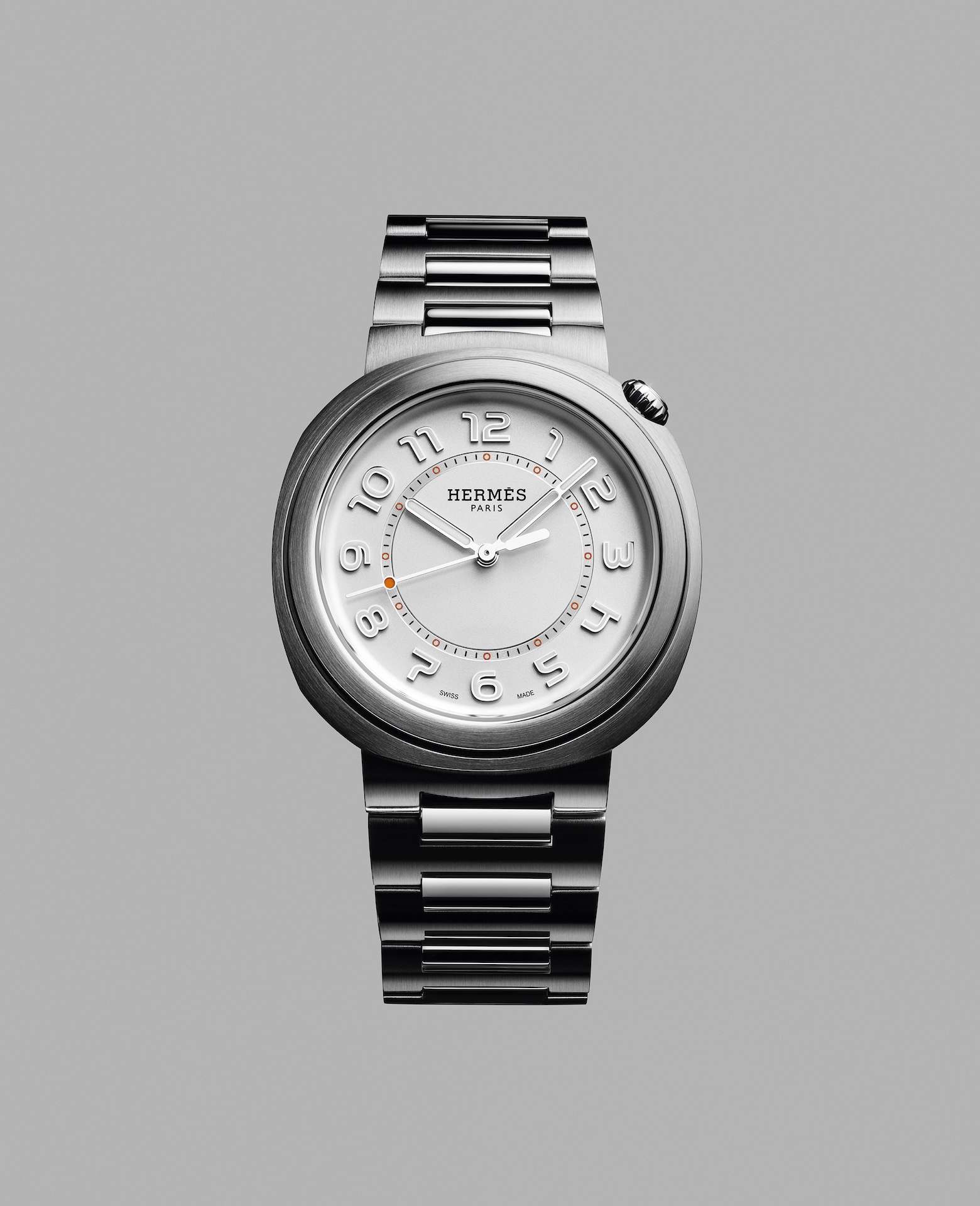
Moving away from the block colours and sporty aesthetic that has defined Hermès watches in recent years, the biggest news from the French luxury goods company at Watches & Wonders came with the unveiling of its newest collection, the Hermès Cut.
It flaunts a round bezel, but the case middle is nearer to a tonneau shape—a relatively simple design that, despite attracting flak from some watch aficionados, works. While marketed as a “women’s watch”, the Cut has universal appeal thanks to its elegant package and proportions. It moves away from the Maison’s penchant for a style-first product; it’s a watch that tells the time, not a fashion accessory with the ability to tell the time.
Hermès gets the proportions just right thanks to a satin-brushed and polished 36 mm case, PVD-treated Arabic numerals, and clean-cut edges that further accentuate its character. One of the key design elements is the positioning of the crown, boldly sitting at half-past one and embellished with a lacquered or engraved “H”, clearly stamping its originality. The watch is powered by a Hermès Manufacture movement H1912, revealed through its sapphire crystal caseback. In addition to its seamlessly integrated and easy-wearing metal bracelet, the Cut also comes with the option for a range of coloured rubber straps. Together with its clever interchangeable system, it’s a cinch to swap out its look.
It will be interesting to see how the Hermès Cut fares in coming months, particularly as it tries to establish its own identity separate from the more aggressive, but widely popular, Ho8 collection. Either way, the company is now a serious part of the dialogue around the concept of time.
—
Read more about this year’s Watches & Wonders exhibition at robbreport.com.au
You may also like.
22/07/2024
Living La Vida Lagerfeld
The world remembers him for fashion. But as a new tome reveals, the iconoclastic designer is defined as much by extravagant, often fantastical, homes as he is clothes.
“Lives, like novels, are made up of chapters”, the world-renowned bibliophile, Karl Lagerfeld, once observed.
Were a psychological-style novel ever to be written about Karl Lagerfeld’s life, it would no doubt give less narrative weight to the story of his reinvigoration of staid fashion houses like Chloe, Fendi and Chanel than to the underpinning leitmotif of the designer’s constant reinvention of himself.
In a lifetime spanning two centuries, Lagerfeld made and dropped an ever-changing parade of close friends, muses, collaborators and ambiguous lovers, as easily as he changed his clothes, his furniture… even his body. Each chapter of this book would be set against the backdrop of one of his series of apartments, houses and villas, whose often wildly divergent but always ultra-luxurious décor reflected the ever-evolving personas of this compulsively public but ultimately enigmatic man.
With the publication of Karl Lagerfeld: A Life in Houses these wildly disparate but always exquisite interiors are presented for the first time together as a chronological body of work. The book indeed serves as a kind of visual novel, documenting the domestic dreamscapes in which the iconic designer played out his many lives, while also making a strong case that Lagerfeld’s impact on contemporary interior design is just as important, if not more so, than his influence on fashion.

In fact, when the first Lagerfeld interior was featured in a 1968 spread for L’OEil magazine, the editorial describes him merely as a “stylist”. The photographs of the apartment in an 18th-century mansion on rue de Université, show walls lined with plum-coloured rice paper, or lacquered deepest chocolate brown in sharp contrast to crisp, white low ceilings that accentuated the horizontality that was fashionable among the extremely fashionable at the time. Yet amid this setting of aggressively au courant modernism, the anachronistic pops of Art Nouveau and Art Deco objects foreshadow the young Karl’s innate gift for creating strikingly original environments whose harmony is achieved through the deft interplay of contrasting styles and contexts.
Lagerfeld learned early on that presenting himself in a succession of gem-like domestic settings was good for crafting his image. But Lagerfeld’s houses not only provided him with publicity, they also gave him an excuse to indulge in his greatest passion. Shopping!
By 1973, Lagerfeld was living in a new apartment at Place Saint–Sulpice where his acquisition of important Art Deco treasures continued unabated. Now a bearded and muscular disco dandy, he could most often be found in the louche company of the models, starlets and assorted hedonistic beauties that gathered around the flamboyant fashion illustrator Antonio Lopez. Lagerfeld was also in the throes of a hopeless love affair with Jacques de Bascher whose favours he reluctantly shared with his nemesis Yves Saint Laurent.
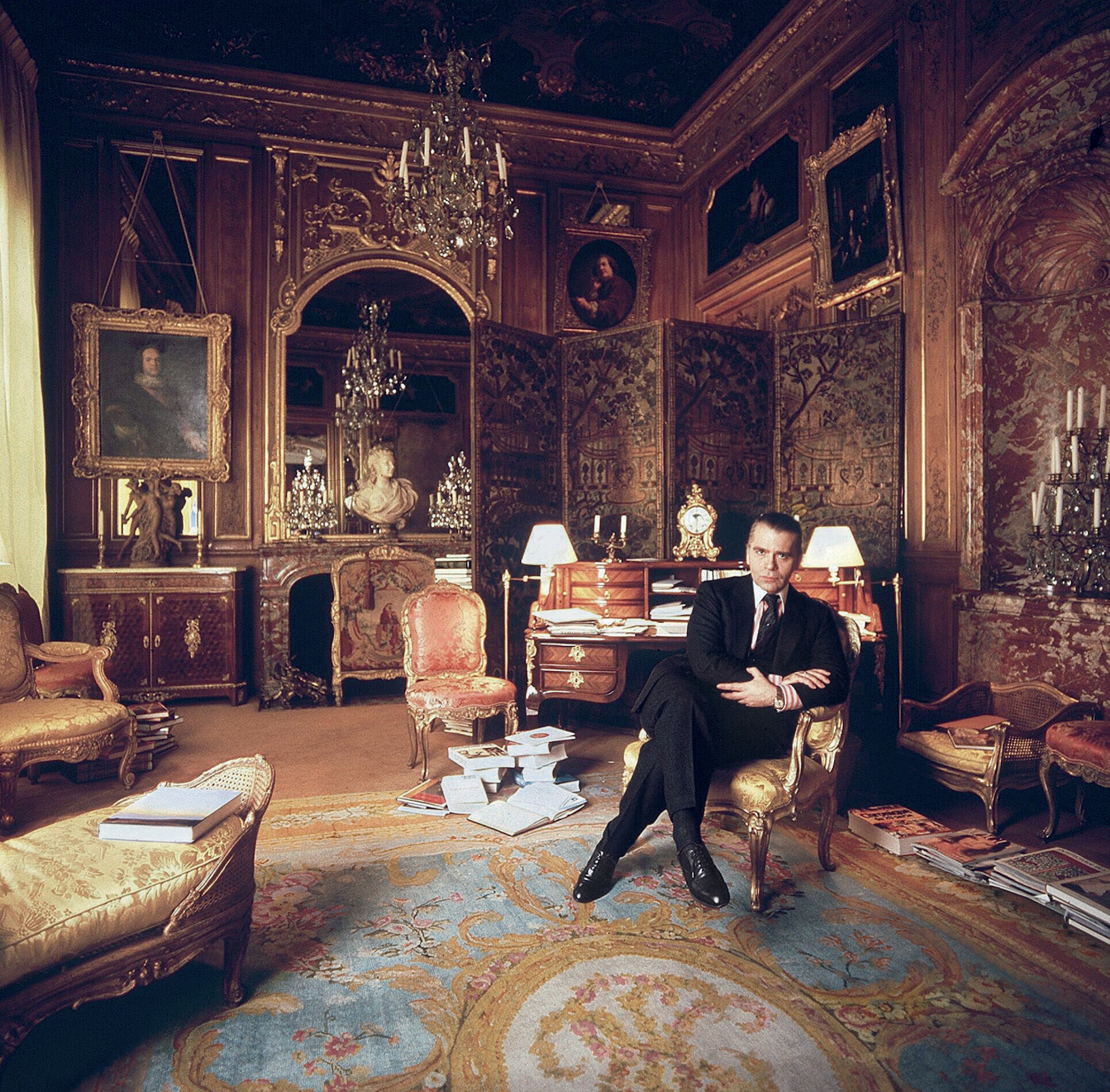
He painted the rooms milky white and lined them with specially commissioned carpets—the tawny patterned striations of which invoked musky wild animal pelts. These lent a stark relief to the sleek, machine-age chrome lines of his Deco furnishings. To contemporary eyes it remains a strikingly original arrangement that subtly conveys the tensions at play in Lagerfeld’s own life: the cocaine fuelled orgies of his lover and friends, hosted in the pristine home of a man who claimed that “a bed is for one person”.
In 1975, a painful falling out with his beloved Jacques, who was descending into the abyss of addiction, saw almost his entire collection of peerless Art Deco furniture, paintings and objects put under the auctioneer’s hammer. This was the first of many auction sales, as he habitually shed the contents of his houses along with whatever incarnation of himself had lived there. Lagerfeld was dispassionate about parting with these precious goods. “It’s collecting that’s fun, not owning,” he said. And the reality for a collector on such a Renaissance scale, is that to continue buying, Lagerfeld had to sell.
Of all his residences, it was the 1977 purchase of Hôtel Pozzo di Borgo, a grand and beautifully preserved 18th-century house, that would finally allow him to fulfill his childhood fantasies of life in the court of Madame de Pompadour. And it was in this aura of Rococó splendour that the fashion designer began to affect, along with his tailored three-piece suits, a courtier’s ponytailed and powdered coif and a coquettish antique fan: marking the beginning of his transformation into a living, breathing global brand that even those with little interest in fashion would immediately recognise.

Lagerfeld’s increasing fame and financial success allowed him to indulge in an unprecedented spending frenzy, competing with deep-pocketed institutions like the Louvre to acquire the finest, most pedigreed pearls of the era—voluptuously carved and gilded bergères; ormolu chests; and fleshy, pastel-tinged Fragonard idylls—to adorn his urban palace. His one-time friend André Leon Talley described him in a contemporary article as suffering from “Versailles complex”.
However, in mid-1981, and in response to the election of left-wing president, François Mitterrand, Lagerfeld, with the assistance of his close friend Princess Caroline, became a resident of the tax haven of Monaco. He purchased two apartments on the 21st floor of Le Roccabella, a luxury residential block designed by Gio Ponti. One, in which he kept Jacques de Bascher, with whom he was now reconciled, was decorated in the strict, monochromatic Viennese Secessionist style that had long underpinned his aesthetic vocabulary; the other space, though, was something else entirely, cementing his notoriety as an iconoclastic tastemaker.
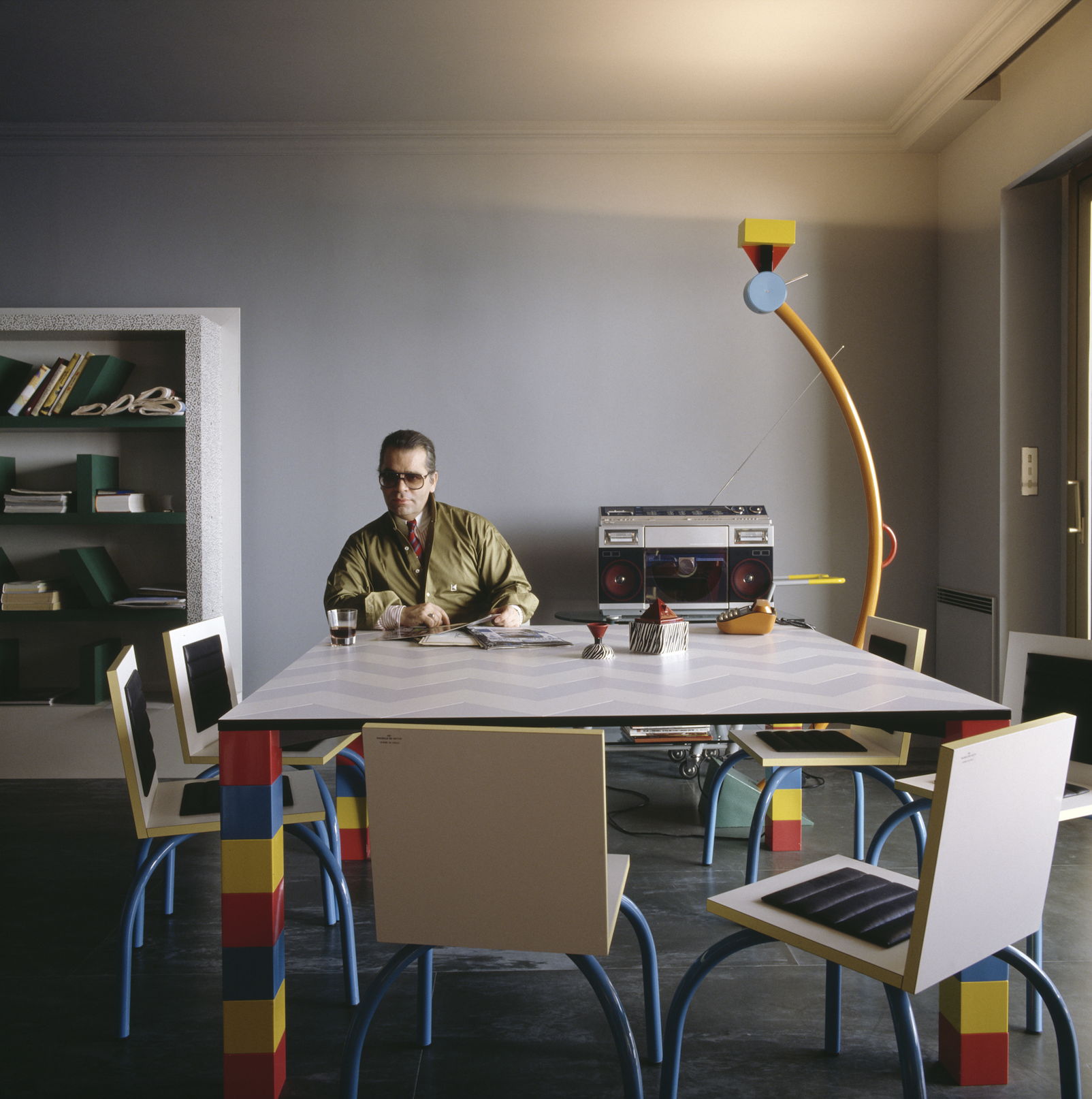
Lagerfeld had recently discovered the radically quirky designs of the Memphis Group led by Ettore Sottsass, and bought the collective’s entire first collection and had it shipped to Monaco. In a space with no right angles, these chaotically colourful, geometrically askew pieces—centred on Masanori Umeda’s famous boxing ring—gave visitors the disorientating sensation of having entered a corporeal comic strip. By 1991, the novelty of this jarring postmodern playhouse had inevitably worn thin and once again he sent it all to auction, later telling a journalist that “after a few years it was like living in an old Courrèges. Ha!”
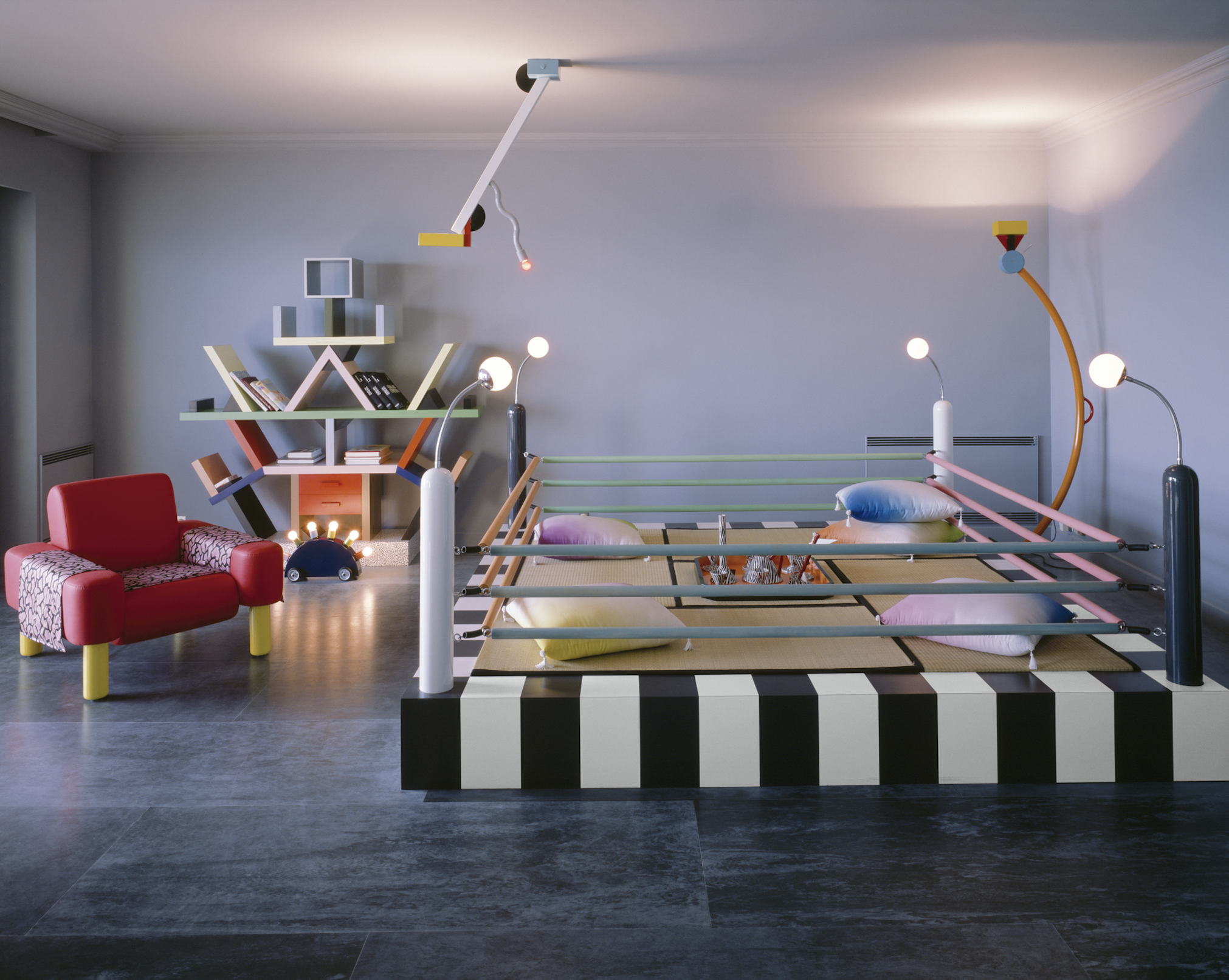
In 1989, de Bascher died of an AIDS-related illness, and while Lagerfeld’s career continued to flourish, emotionally the famously stoic designer was struggling. In 2000, a somewhat corpulent Lagerfeld officially ended his “let them eat cake” years at the Hôtel Pozzo di Borgo, selling its sumptuous antique fittings in a massive headline auction that stretched over three days. As always there were other houses, but now with his longtime companion dead, and his celebrity metastasising making him a target for the paparazzi, he began to look less for exhibition spaces and more for private sanctuaries where he could pursue his endless, often lonely, work.
His next significant house was Villa Jako, named for his lost companion and built in the 1920s in a nouveau riche area of Hamburg close to where he grew up. Lagerfeld shot the advertising campaign for Lagerfeld Jako there—a fragrance created in memorial to de Bascher. The house featured a collection of mainly Scandinavian antiques, marking the aesthetic cusp between Art Nouveau and Art Deco. One of its rooms Lagerfeld decorated based on his remembrances of his childhood nursery. Here, he locked himself away to work—tellingly—on a series of illustrations for the fairy tale, The Emperor’s New Clothes. Villa Jako was a house of deep nostalgia and mourning.
But there were more acts—and more houses—to come in Lagerfeld’s life yet. In November 2000, upon seeing the attenuated tailoring of Hedi Slimane, then head of menswear at Christian Dior, the 135 kg Lagerfeld embarked on a strict dietary regime. Over the next 13 months, he melted into a shadow of his former self. It is this incarnation of Lagerfeld—high white starched collars; Slimane’s skintight suits, and fingerless leather gloves revealing hands bedecked with heavy silver rings—that is immediately recognisable some five years after his death.
The 200-year-old apartment in Quái Voltaire, Paris, was purchased in 2006, and after years of slumber Lagerfeld—a newly awakened Hip Van Winkle—was ready to remake it into his last modernist masterpiece. He designed a unique daylight simulation system that meant the monochromatic space was completely without shadows—and without memory. The walls were frosted and smoked glass, the floors concrete and silicone; and any hint of texture was banned with only shiny, sleek pieces by Marc Newson, Martin Szekely and the Bouroullec Brothers permitted. Few guests were allowed into this monastic environment where Lagerfeld worked, drank endless cans of Diet Coke and communed with Choupette, his beloved Birman cat, and parts of his collection of 300,000 books—one of the largest private collections in the world.
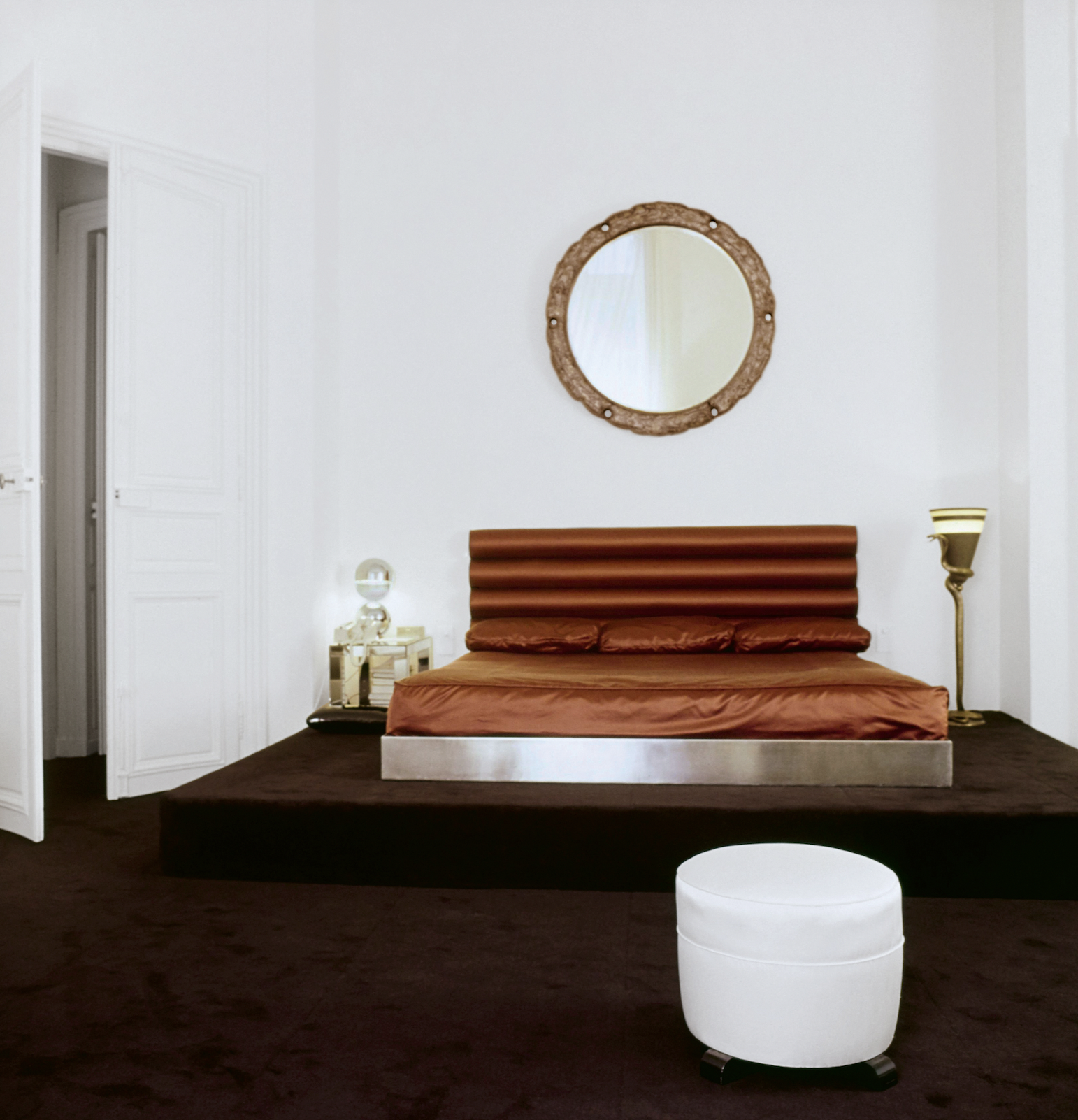
Lagerfeld died in 2019, and the process of dispersing his worldly goods is still ongoing. The Quái Voltaire apartment was sold this year for US$10.8 million (around $16.3 million). Now only the rue de Saint-Peres property remains within the Lagerfeld trust. Purchased after Quái Voltaire to further accommodate more of his books—35,000 were displayed in his studio alone, always stacked horizontally so he could read the titles without straining his neck—and as a place for food preparation as he loathed his primary living space having any trace of cooking smells. Today, the rue de Saint-Peres residence is open to the public as an arts performance space and most fittingly, a library.
You may also like.
By Josh Bozin
24/07/2024
Watch This Space: Mike Nouveau
Meet the game-changing horological influencers blazing a trail across social media—and doing things their own way.
In the thriving world of luxury watches, few people own a space that offers unfiltered digital amplification. And that’s precisely what makes the likes of Brynn Wallner, Teddy Baldassarre, Mike Nouveau and Justin Hast so compelling.
These thought-provoking digital crusaders are now paving the way for the story of watches to be told, and shown, in a new light. Speaking to thousands of followers on the daily—mainly via TikTok, Instagram and YouTube—these progressive commentators represent the new guard of watch pundits. And they’re swaying the opinions, and dollars, of the up-and-coming generations who now represent the target consumer of this booming sector.
—
MIKE NOUVEAU

Can we please see what’s on the wrist? That’s the question that catapulted Mike Nouveau into watch stardom, thanks to his penchant for highlighting incredibly rare timepieces across his TikTok account of more than 400,000 followers. When viewing Nouveau’s attention-grabbing video clips—usually shot in a New York City neighbourhood—it’s not uncommon to find him wrist-rolling some of the world’s rarest timepieces, like the million-dollar Cartier Cheich (a clip he posted in May).
But how did someone without any previous watch experience come to amass such a cult following, and in the process gain access to some of the world’s most coveted timepieces? Nouveau admits had been a collector for many years, but moved didn’t move into horology full-time until 2020, when he swapped his DJing career for one as a vintage watch specialist.
“I probably researched for a year before I even bought my first watch,” says Nouveau, alluding to his Rolex GMT Master “Pepsi” ref. 1675 from 1967, a lionised timepiece in the vintage cosmos. “I would see deals arise that I knew were very good, but they weren’t necessarily watches that I wanted to buy myself. I eventually started buying and selling, flipping just for fun because I knew how to spot a good deal.”
Nouveau claims that before launching his TikTok account in the wake of Covid-19, no one in the watch community knew he existed. “There really wasn’t much watch content, if any, on TikTok before I started posting, especially talking about vintage watches. There’s still not that many voices for vintage watches, period,” says Nouveau. “It just so happens that my audience probably skews younger, and I’d say there are just as many young people interested in vintage watches as there are in modern watches.”
View this post on Instagram
Nouveau recently posted a video to his TikTok account revealing that the average price of a watch purchased by Gen Z is now almost US$11,000 (around $16,500), with 41 percent of them coming into possession of a luxury watch in the past 12 months.
“Do as much independent research as you can [when buying],” he advises. “The more you do, the more informed you are and the less likely you are to make a mistake. And don’t bring modern watch expectations to the vintage world because it’s very different. People say, ‘buy the dealer’, but I don’t do that. I trust myself and myself only.”
—
Read more about the influencers shaking up horology here with Justin Hast, Brynn Wallner and Teddy Baldassare.
You may also like.
By Josh Bozin
24/07/2024
This Pristine 1960 Ferrari 250 Spider Could Fetch $24 Million at Auction
The car wears the same colours and has the same engine it left the factory with.
Some Ferraris are just a little bit more important than others.
Take, for example, the 1960 250 GT SWB California that RM Sotheby’s is auctioning off during this year’s Monterey Car Week. Any example of the open-top beauty would attract interest, but this one just so happens to be the first one that was built.
The 250 is one of the most legendary series of cars in Ferrari history. Between 1952 and 1964, the company released 21 different 250 models—seven for racetracks, 14 for public roads—of which the “Cali Spider” might be the most well regarded, thanks to its potent V-12 and a Pininfarina-penned design that is one of the most beautiful bodies to grace an automobile. The roadster, which was specifically built for the U.S., made its debut in 1957 as a long-wheel-base model (LWB), but it wasn’t until the SWB model debut in 1960 that it became clear how special it was. This example isn’t just the first to roll off the line. It’s the actual car that was used to introduce the world to the model at the 1960 Geneva Motor Show.

Just 56 examples of the 250 GT SWB California Spider would be built by Scaglietti during the three years it was in production. The first of those, chassis 1795 GT, is finished in a glossy coat of Grigio. The two-door had a red leather interior at Geneva but was returned to the factory and re-outfitted with black leather upholstery before being delivered to its original owner, British race car driver John Gordon Bennet. Six-and-a-half decades later the car looks identical to how it did when it left the factory the second time.

In addition to its original bodywork, the chassis 1795 GT features its original engine, gearbox, and rear axle. That mill is the competition-spec Tipo 168, a 3.0-litre V-12 that makes 196.1 kW. That may not sound like much by today’s standards, but, when you consider that the 250 GT SWB California Spider tips the scales around 952 kilograms, it’s more than enough.
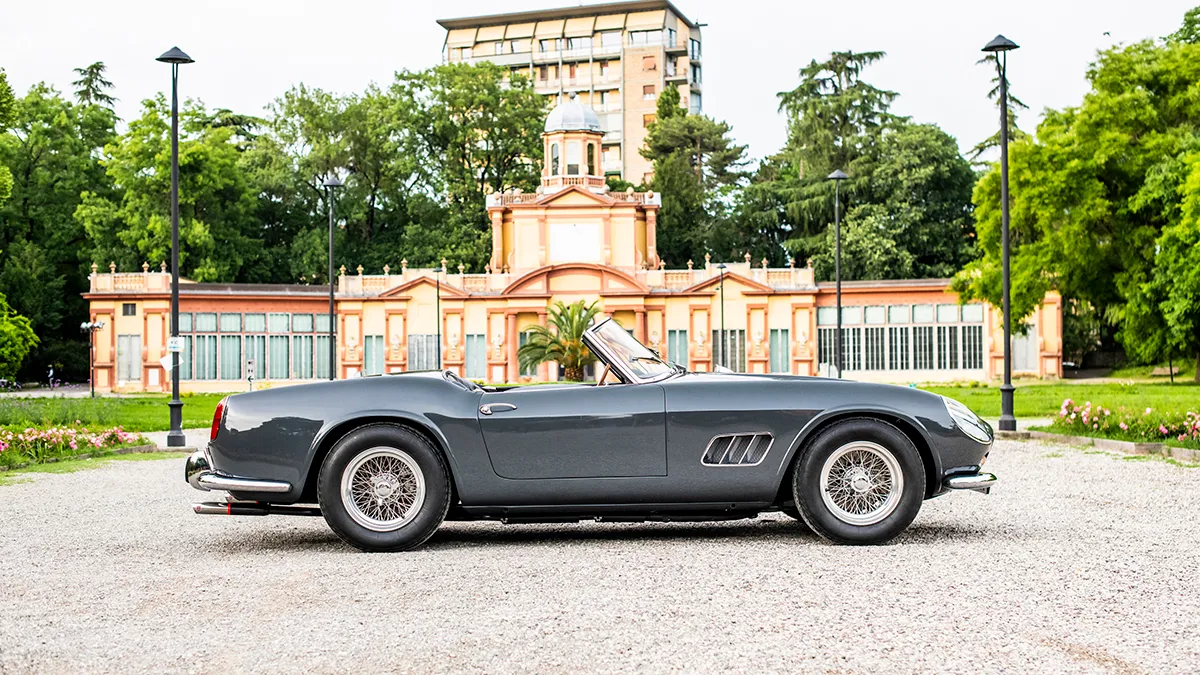
The first 250 GT SWB California Spider is scheduled to go up for bid during RM Sotheby’s annual Monterey Car Week auction, which runs from Thursday, August 15, to Saturday, August 17. Unsurprisingly, the house has quite high hopes for the car. The car carries an estimate of between $24 million and $26 million, which could make it one of the most expensive cars ever sold at auction.

You may also like.
By Josh Bozin
24/07/2024

















